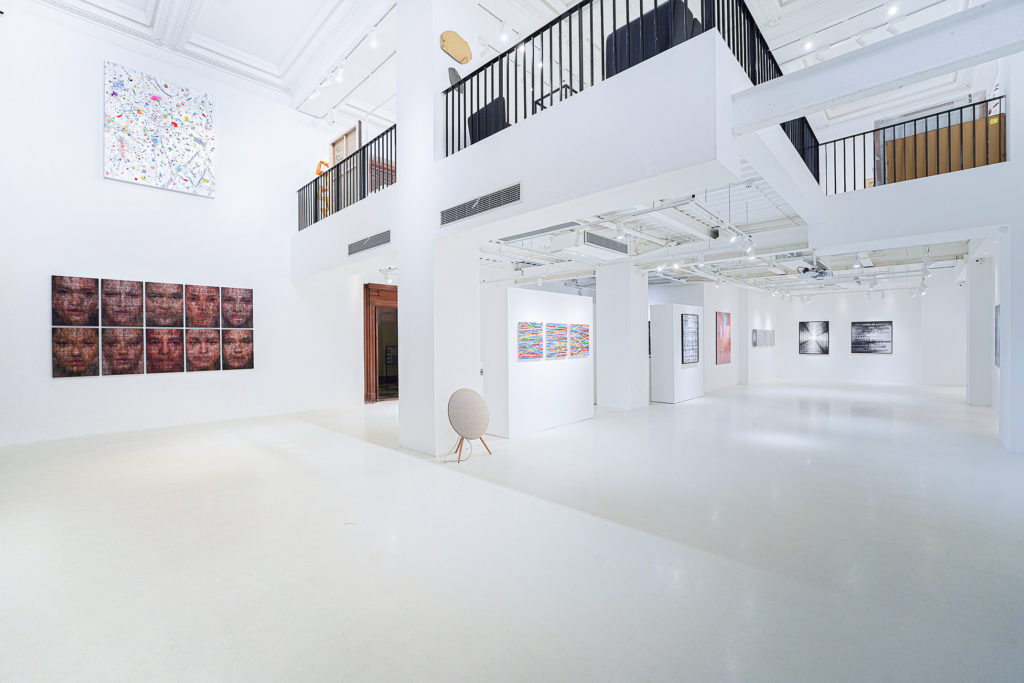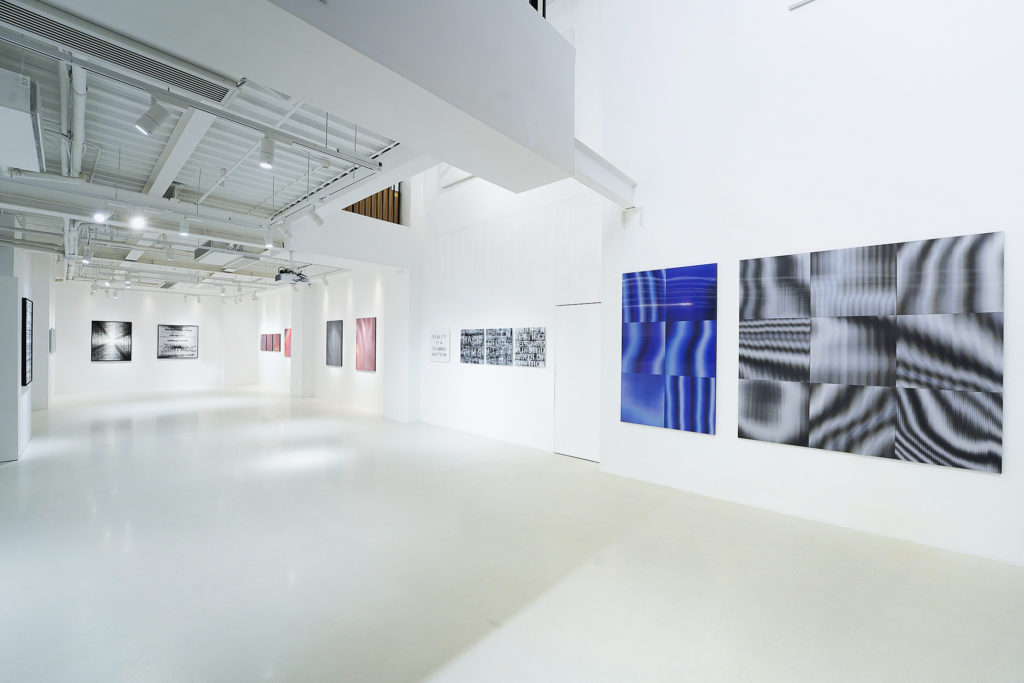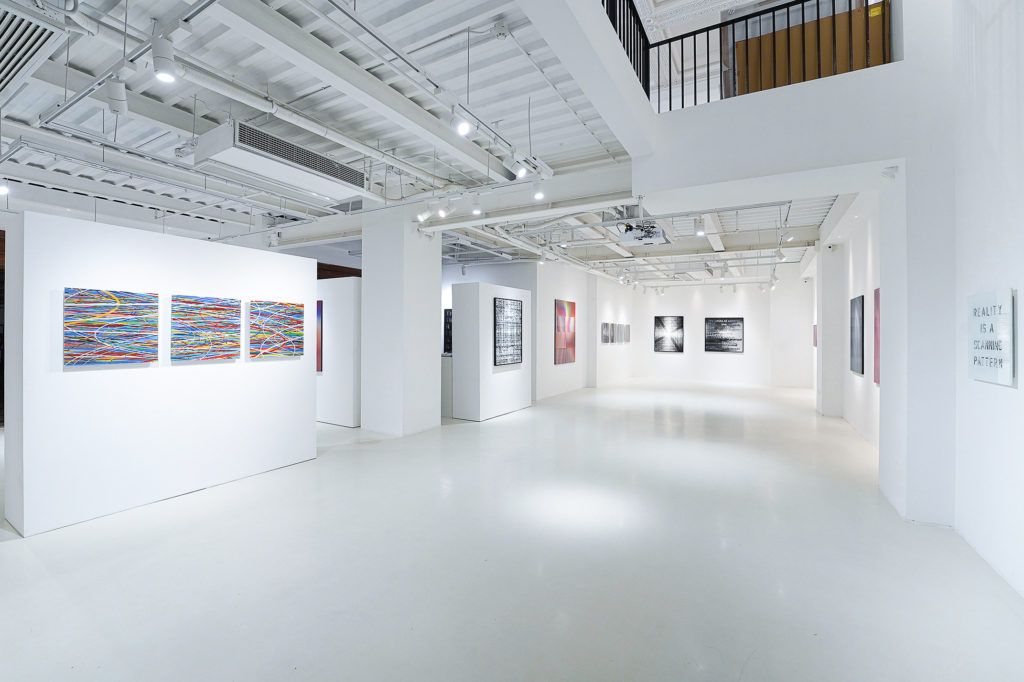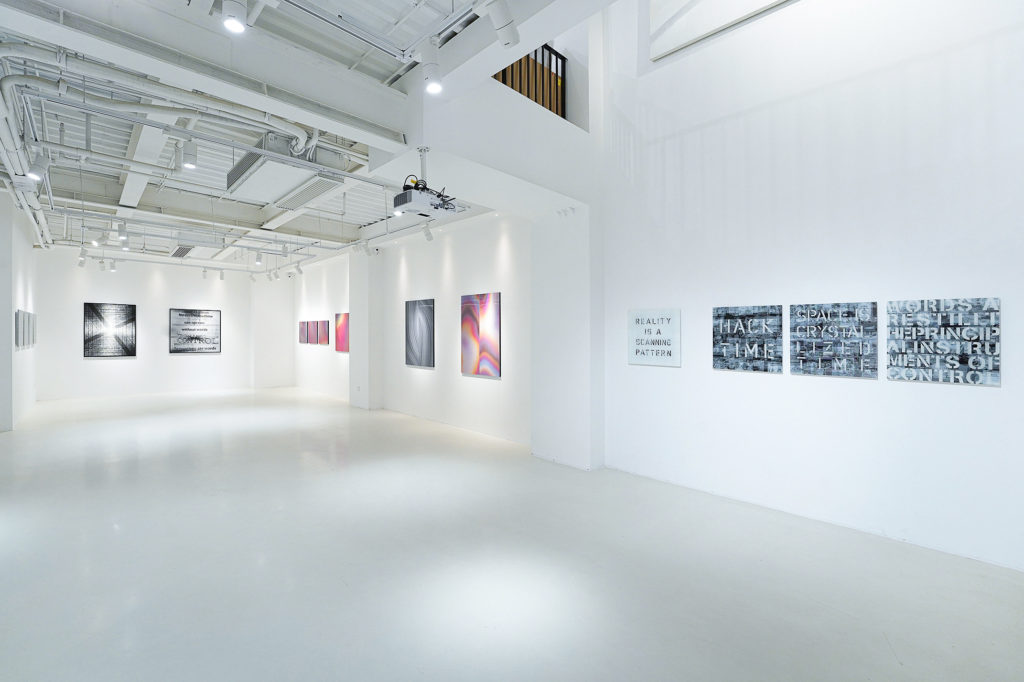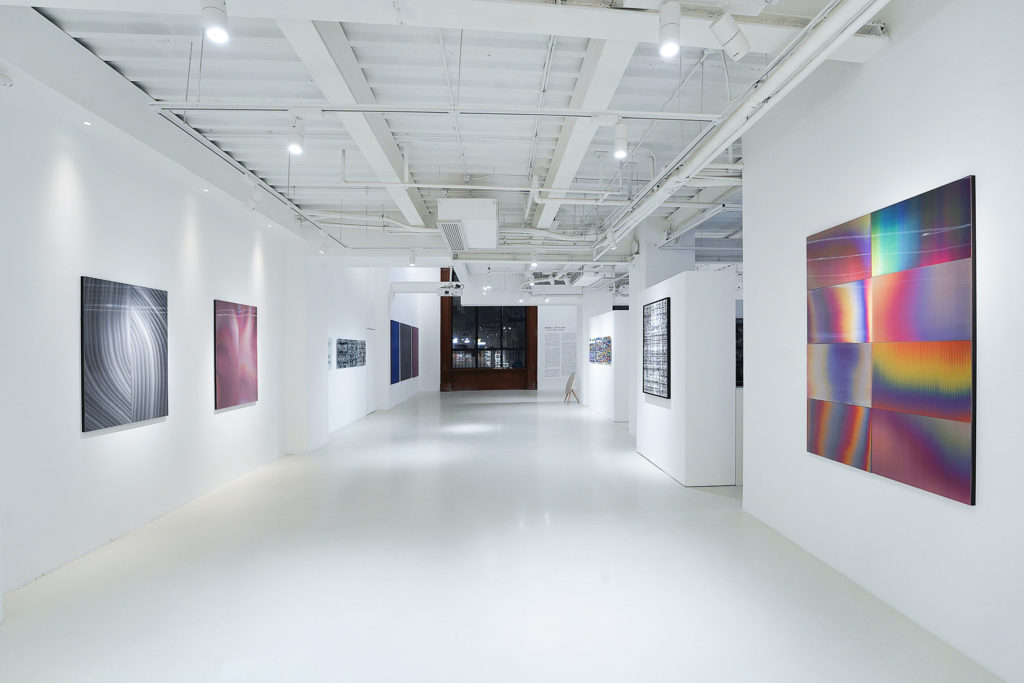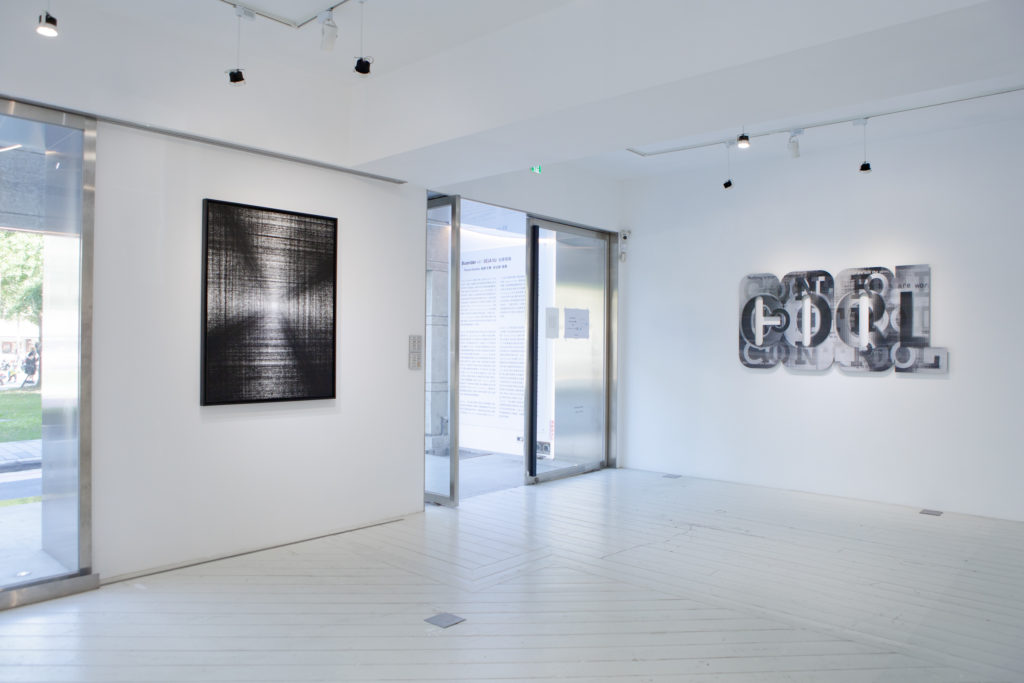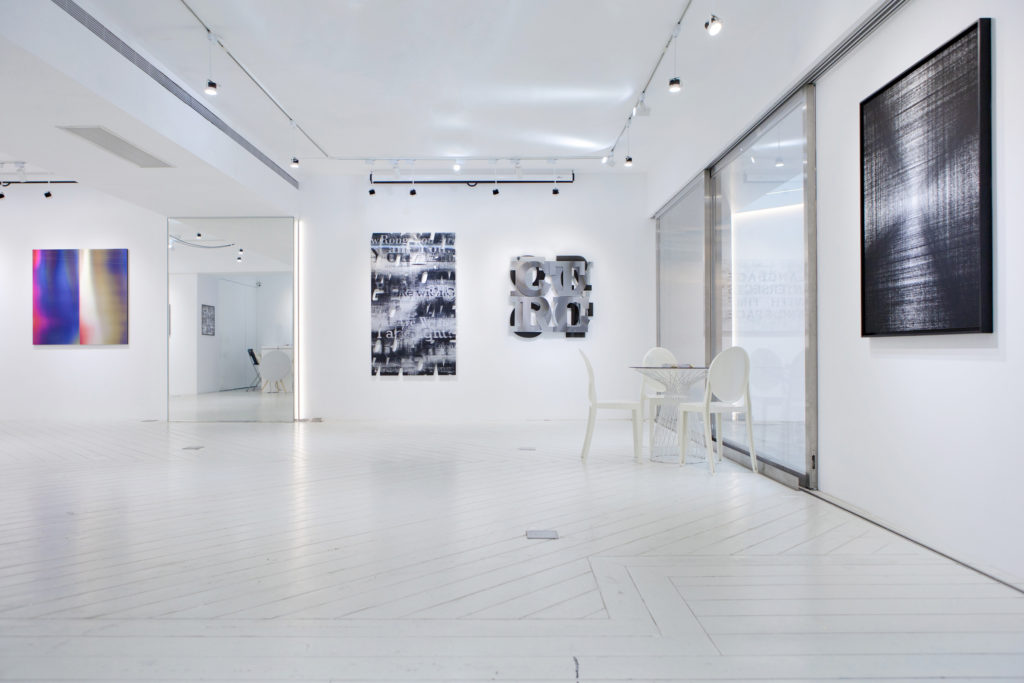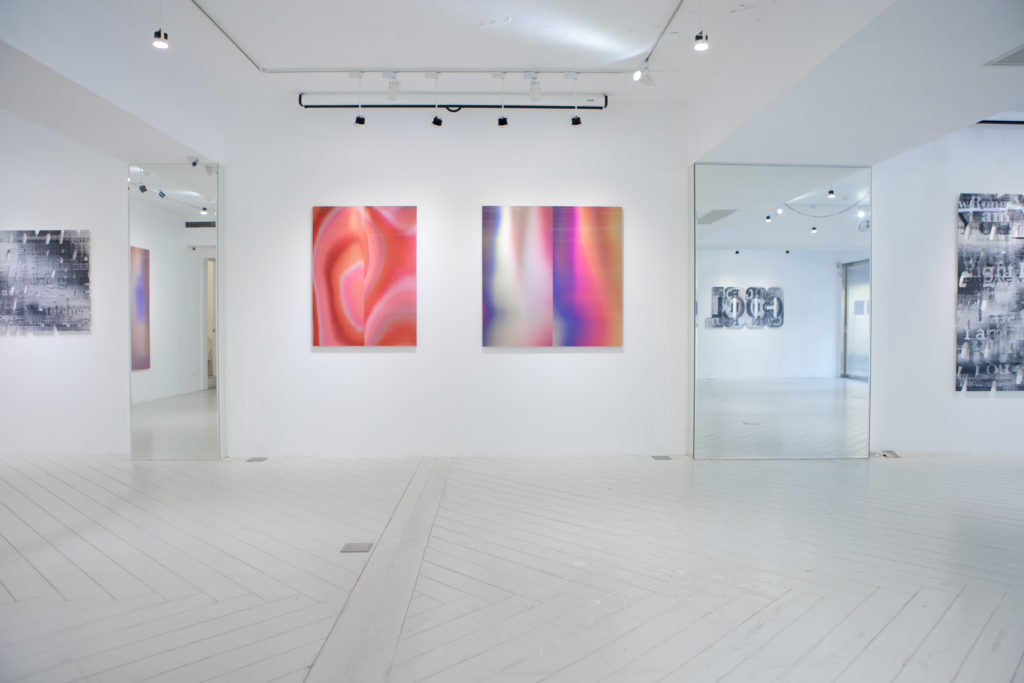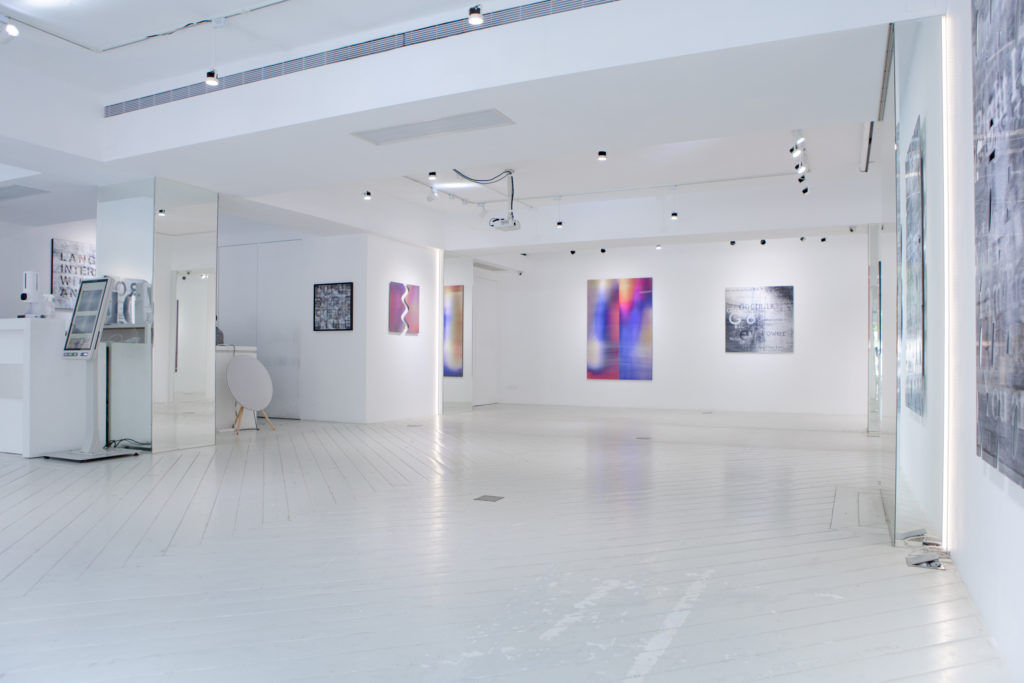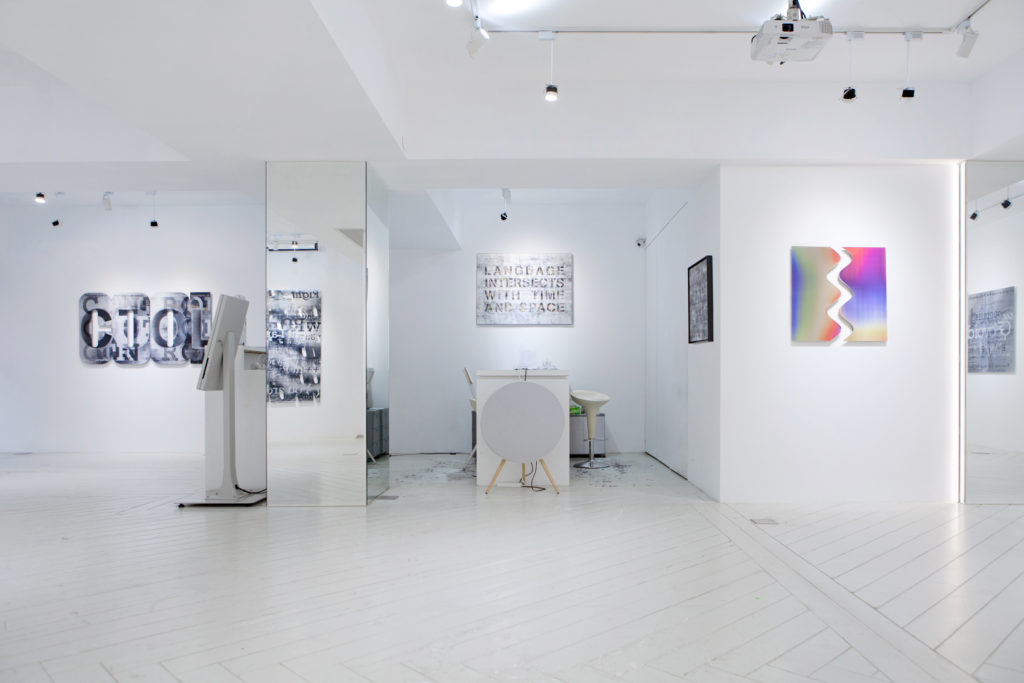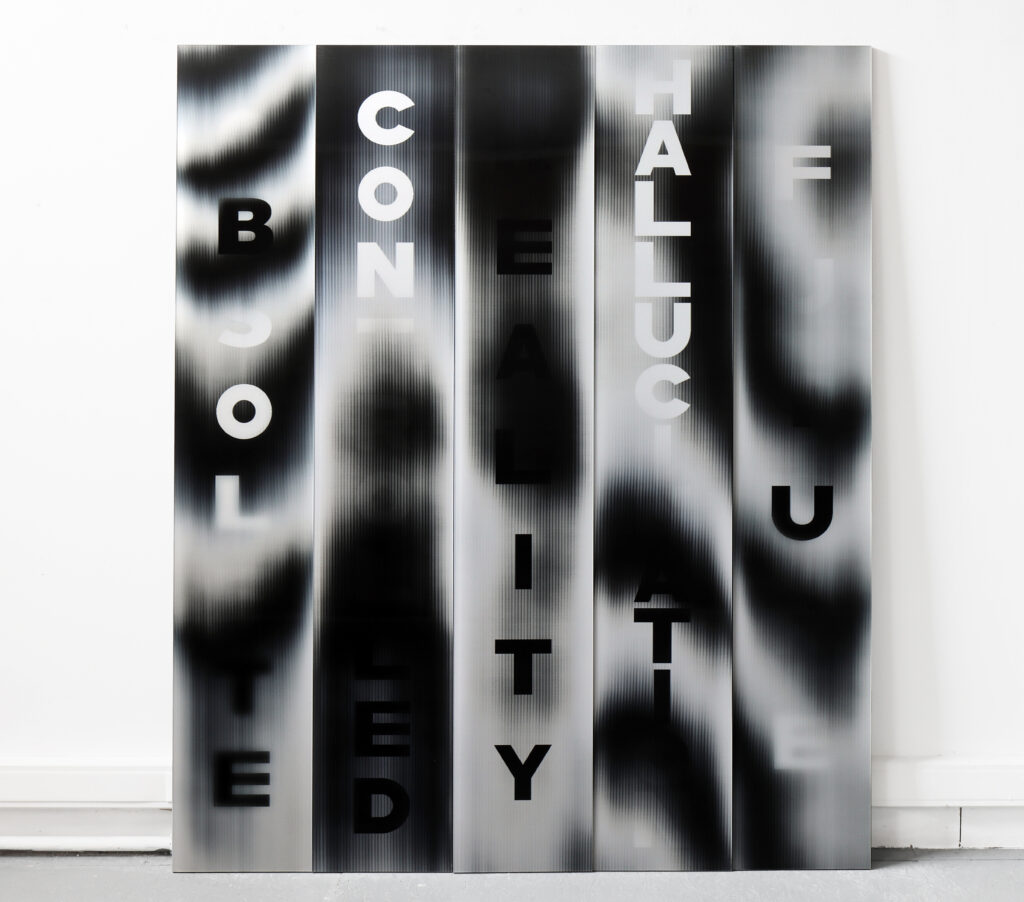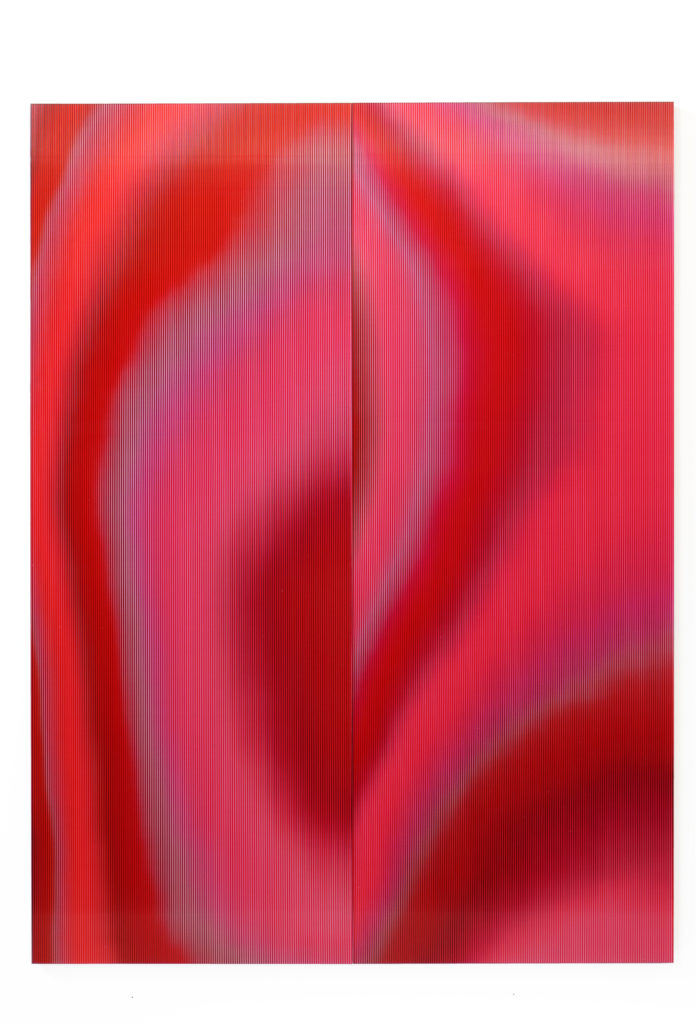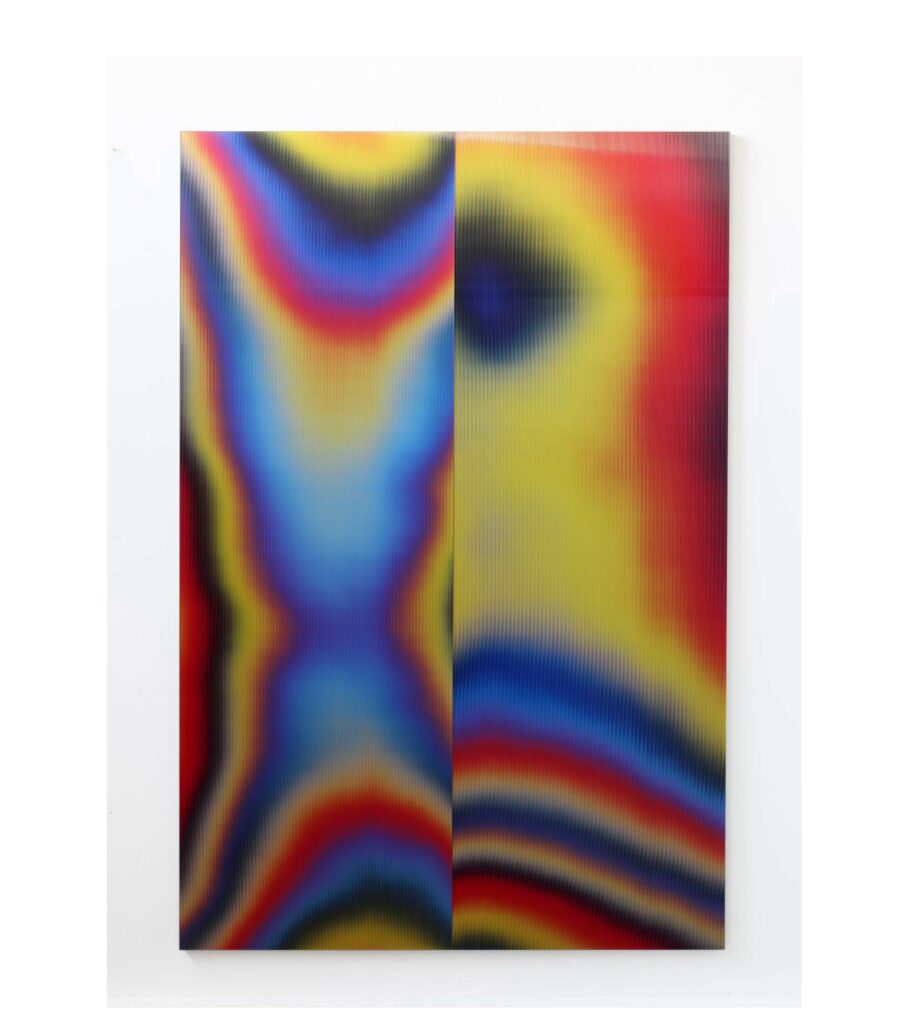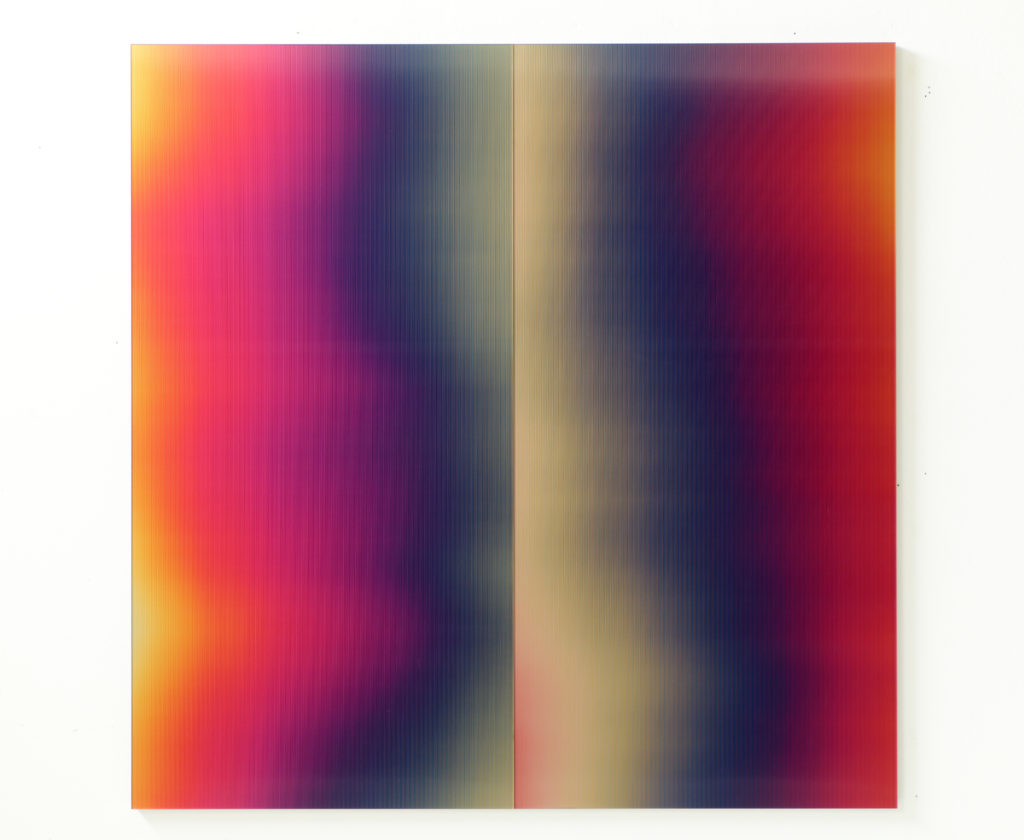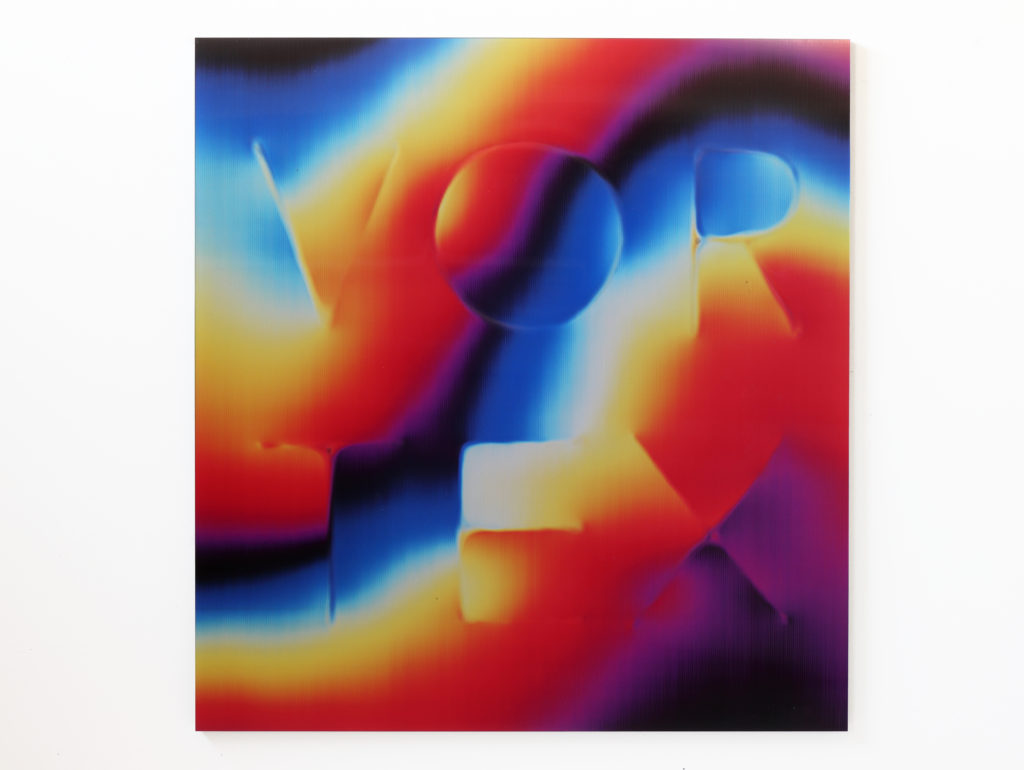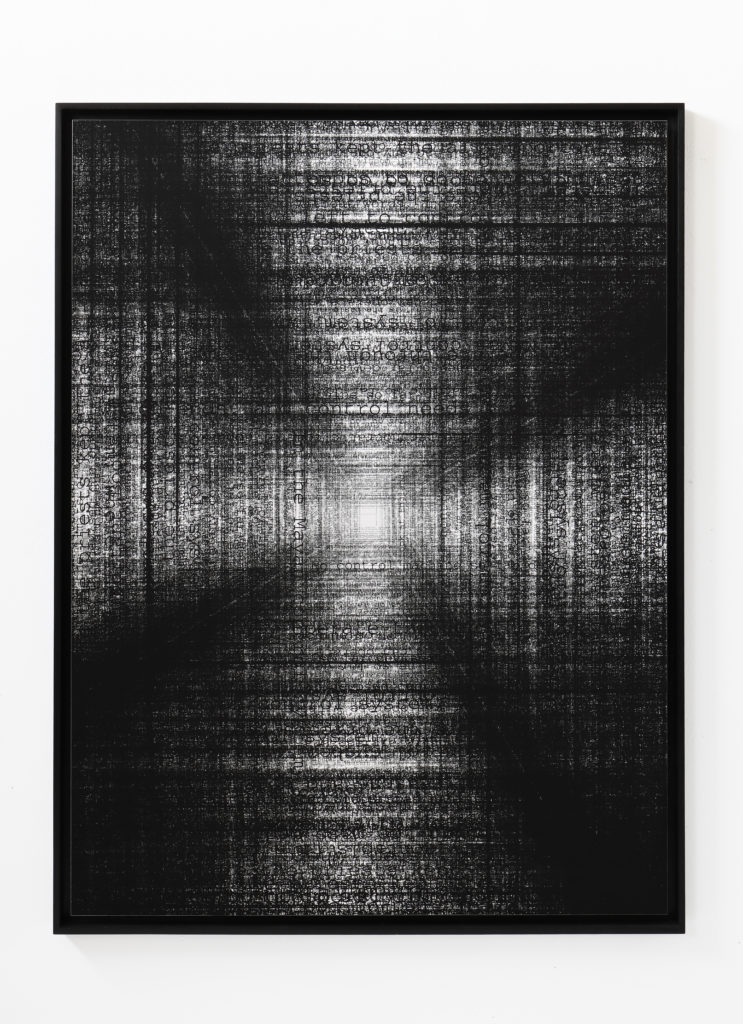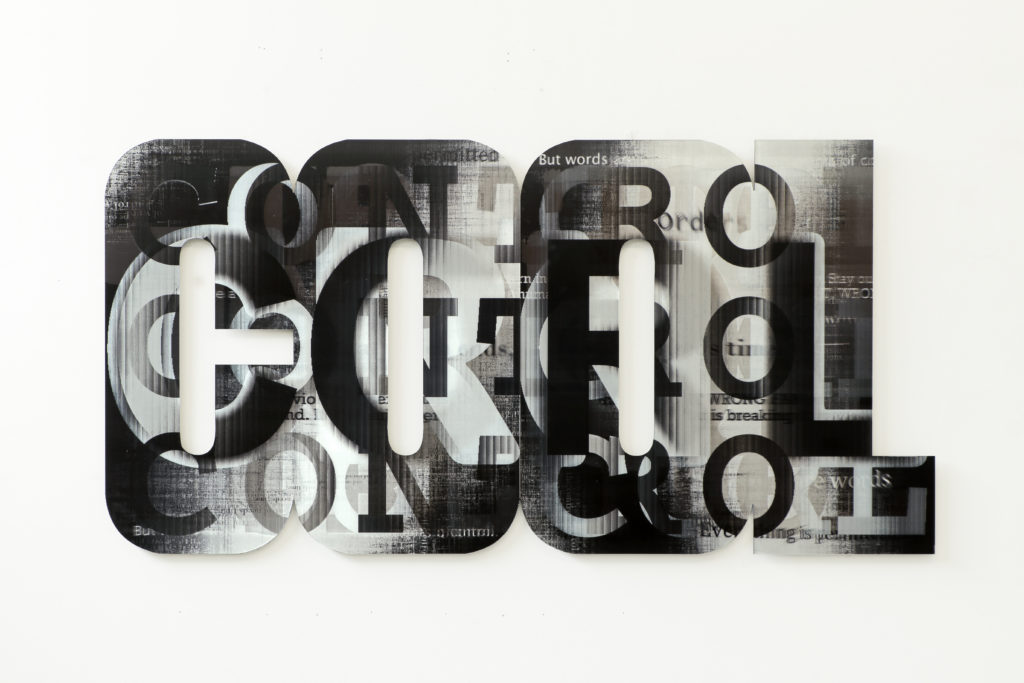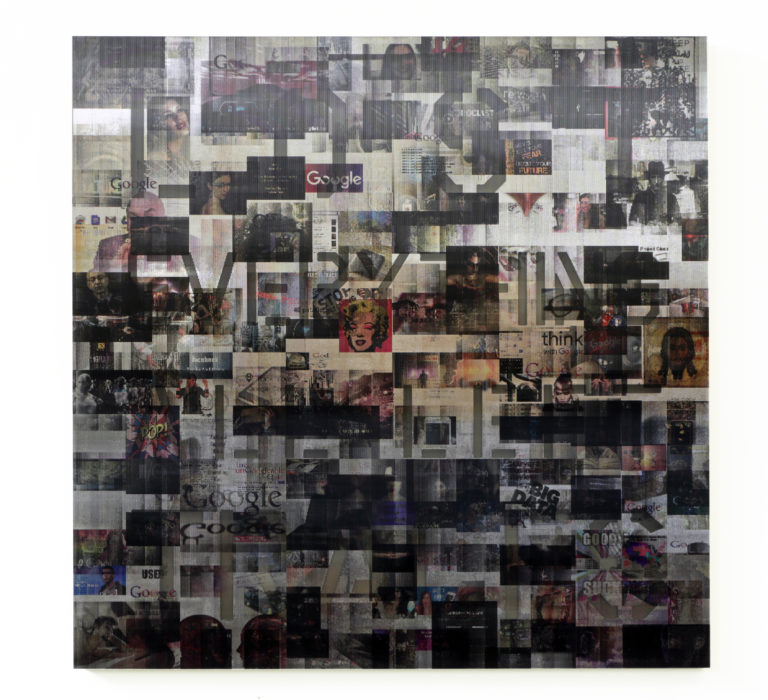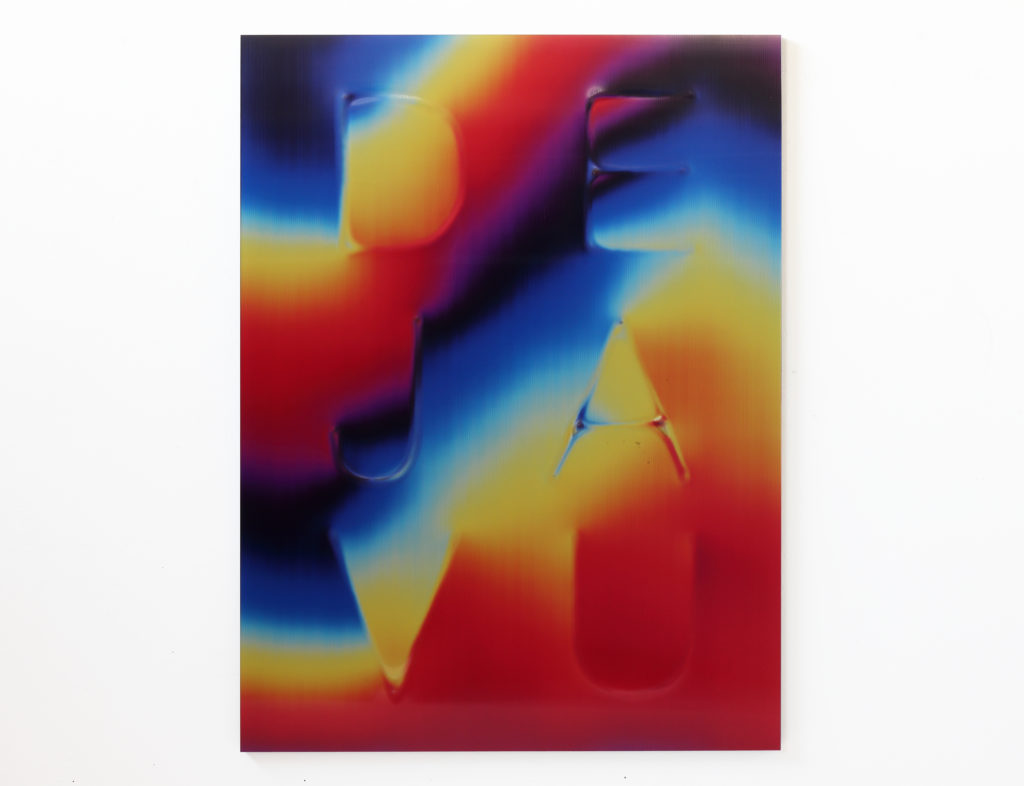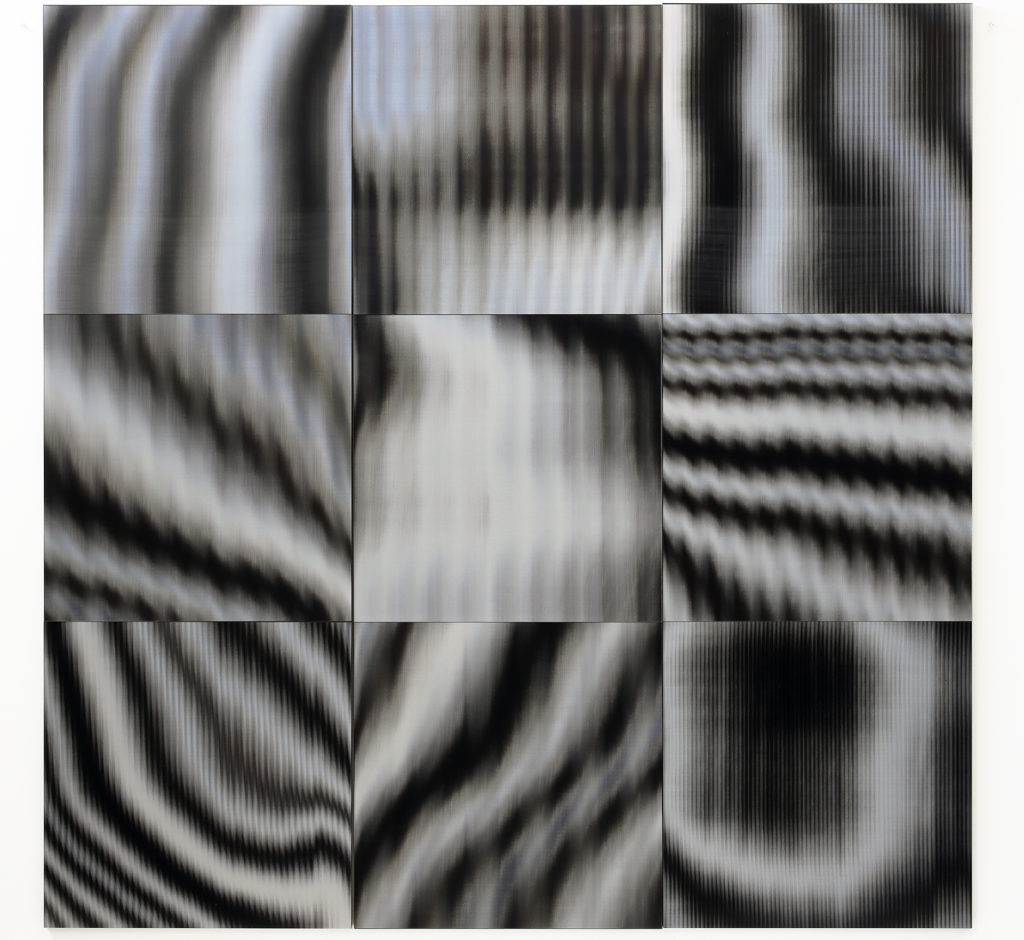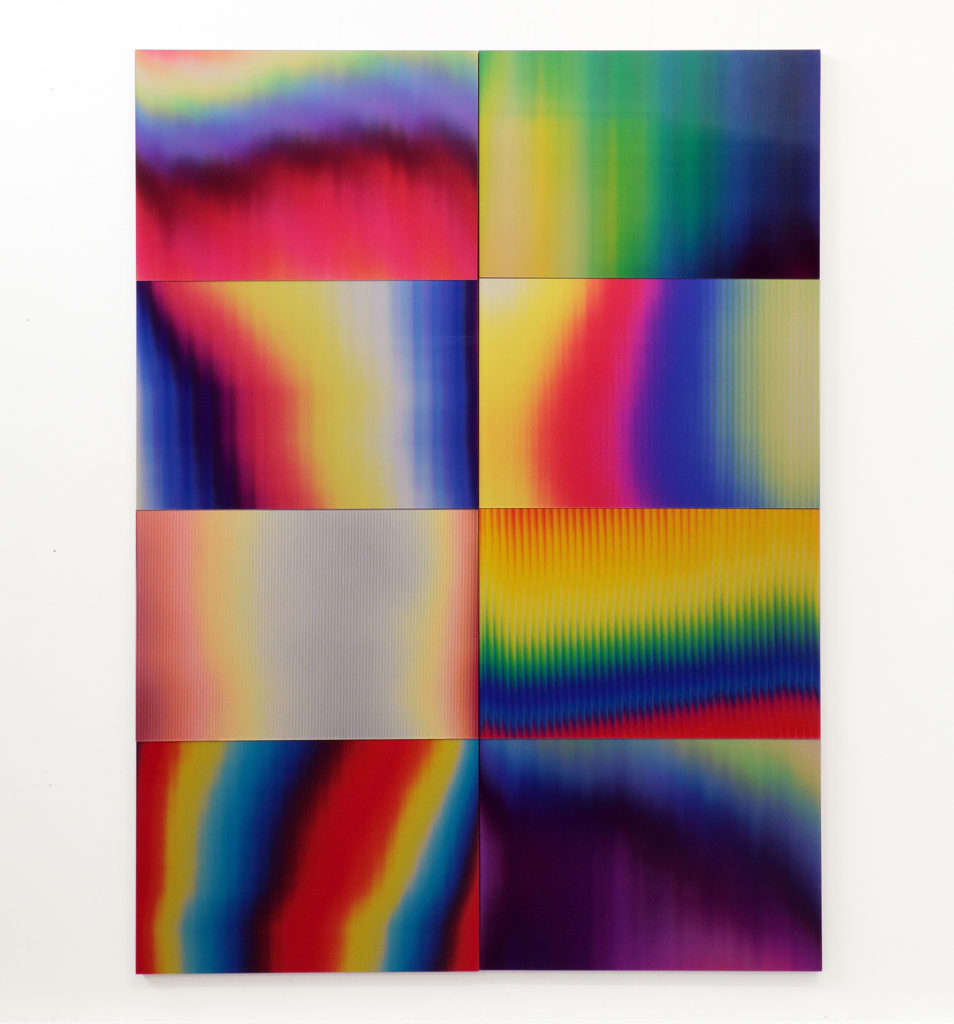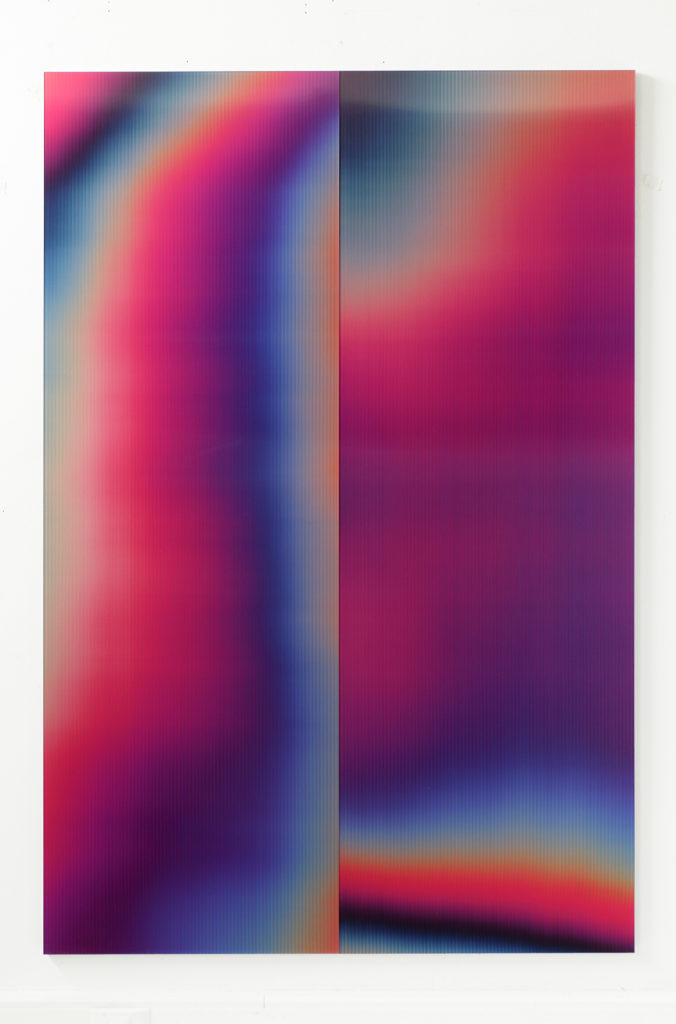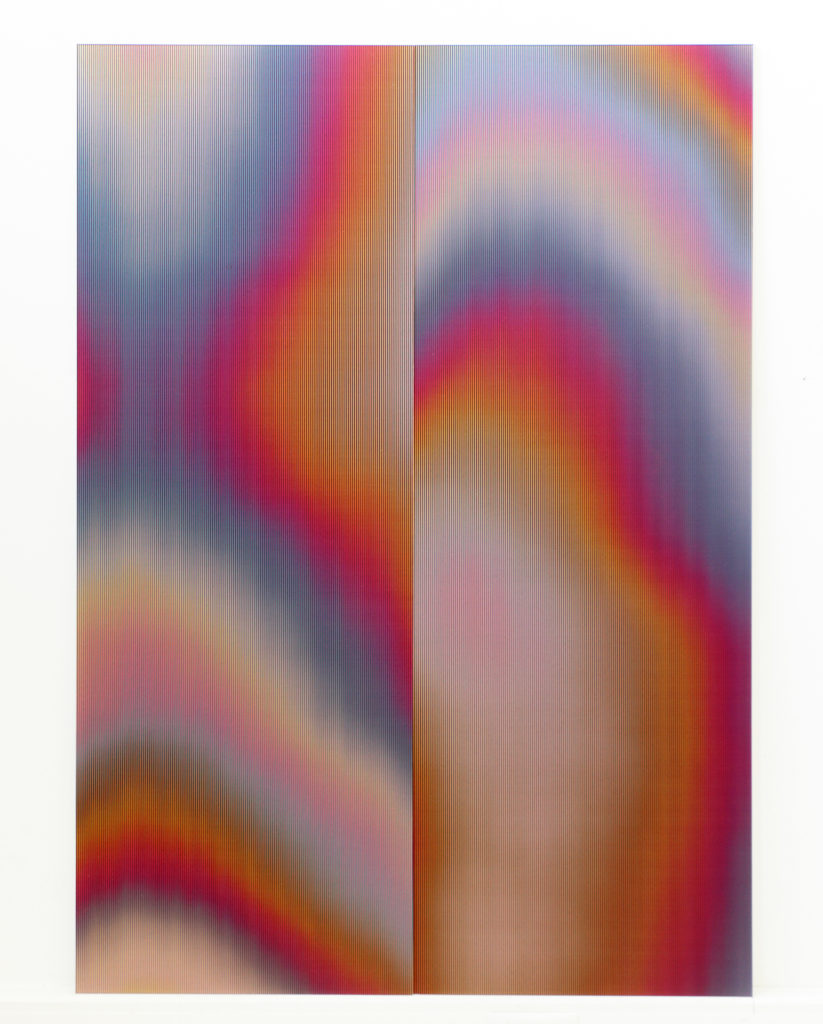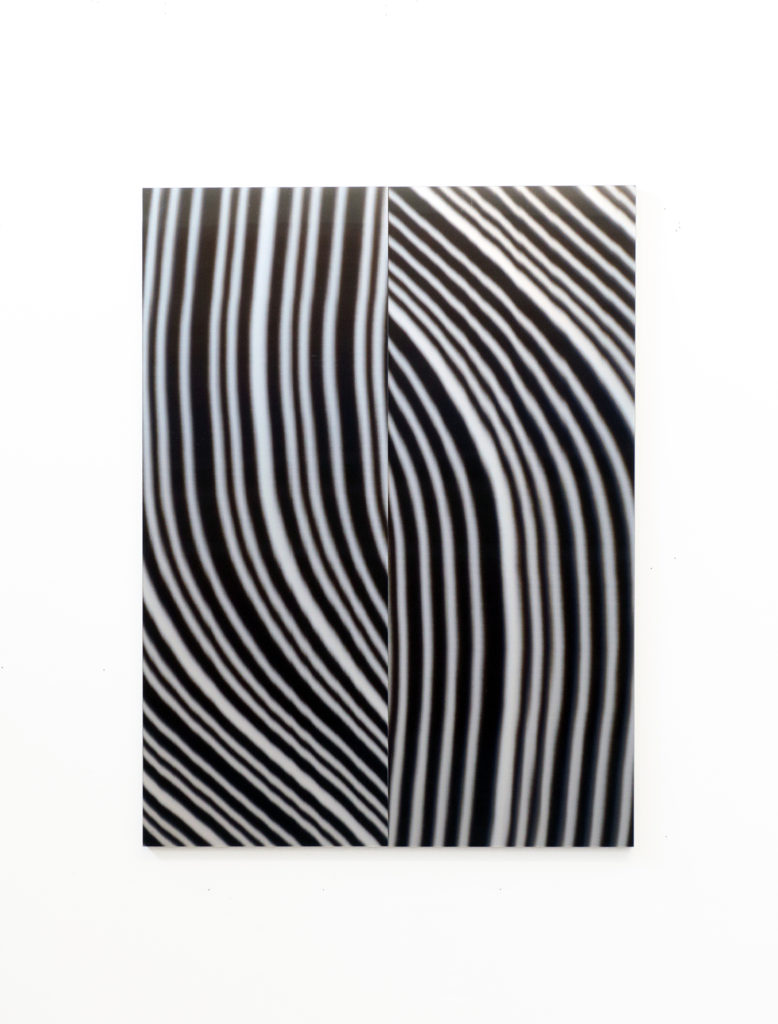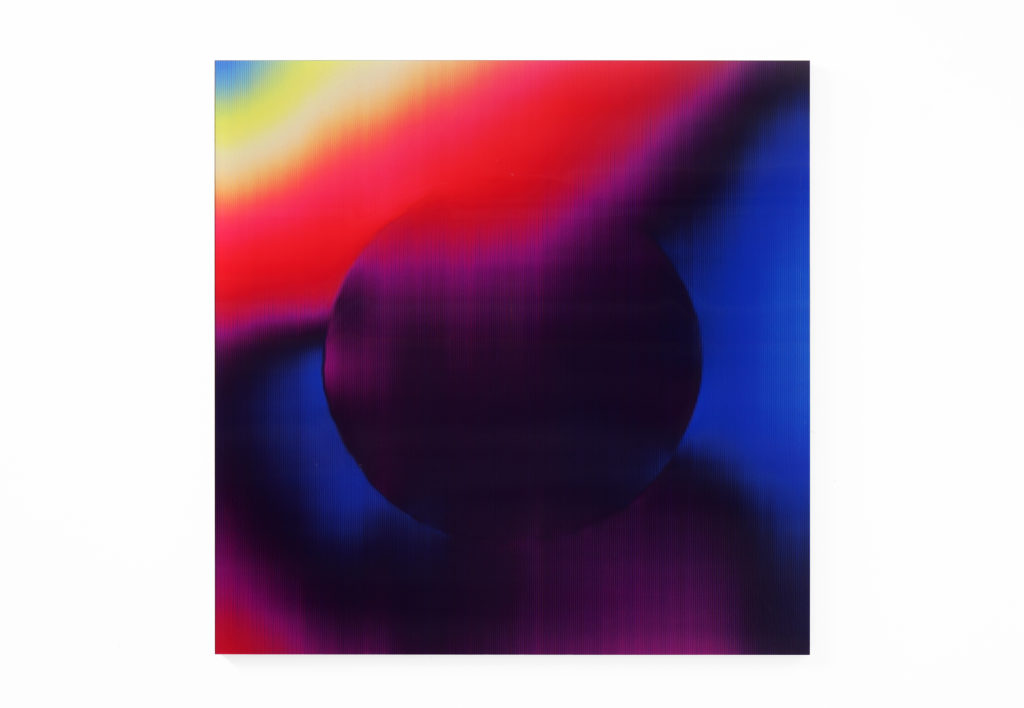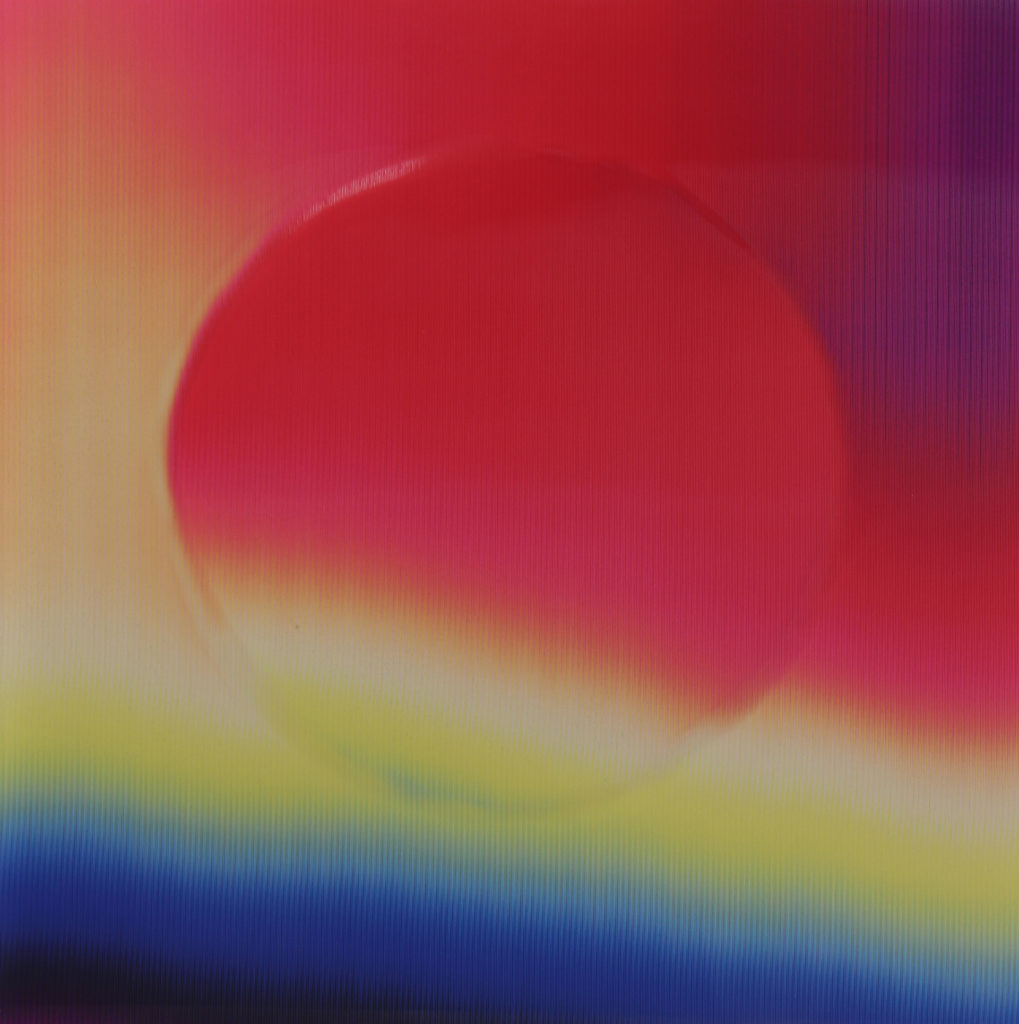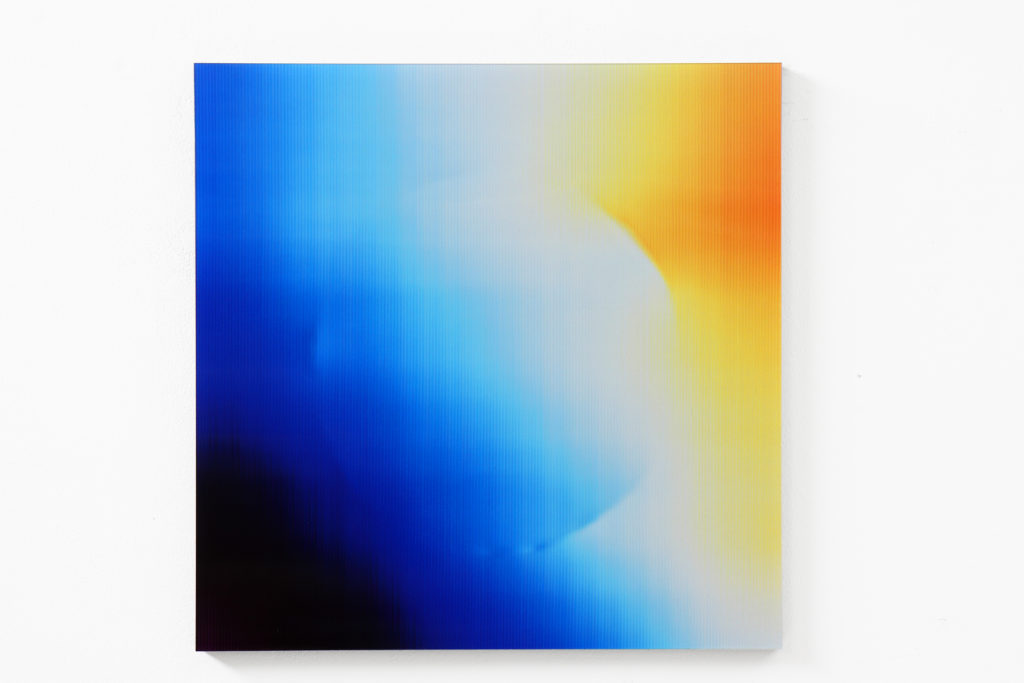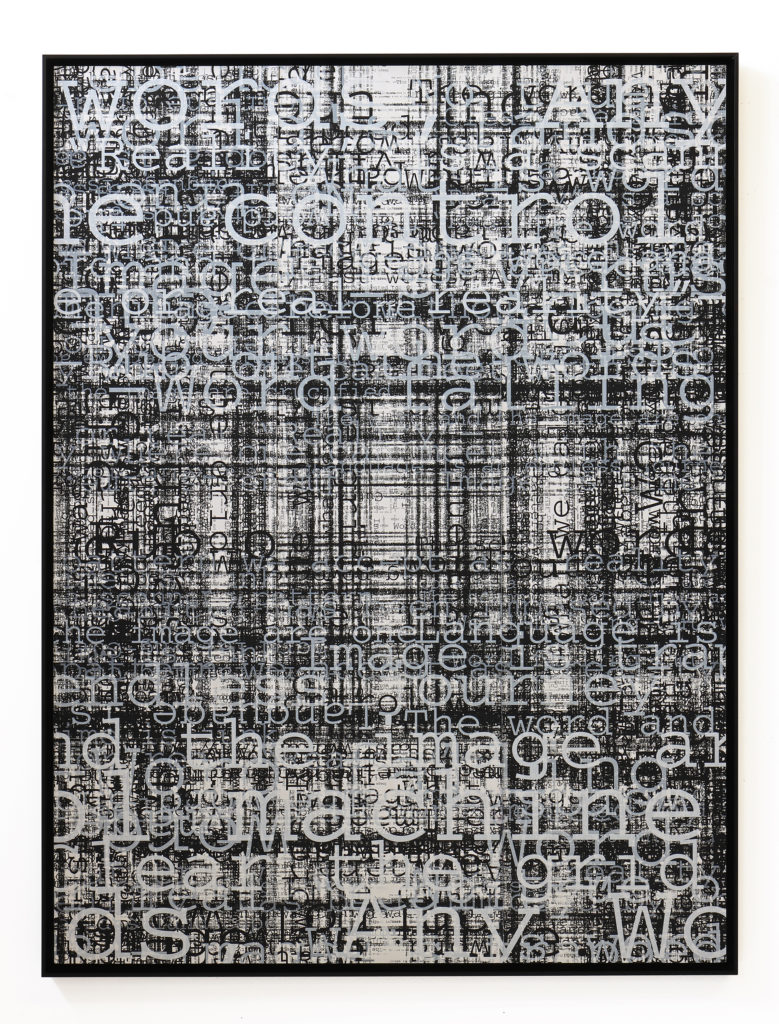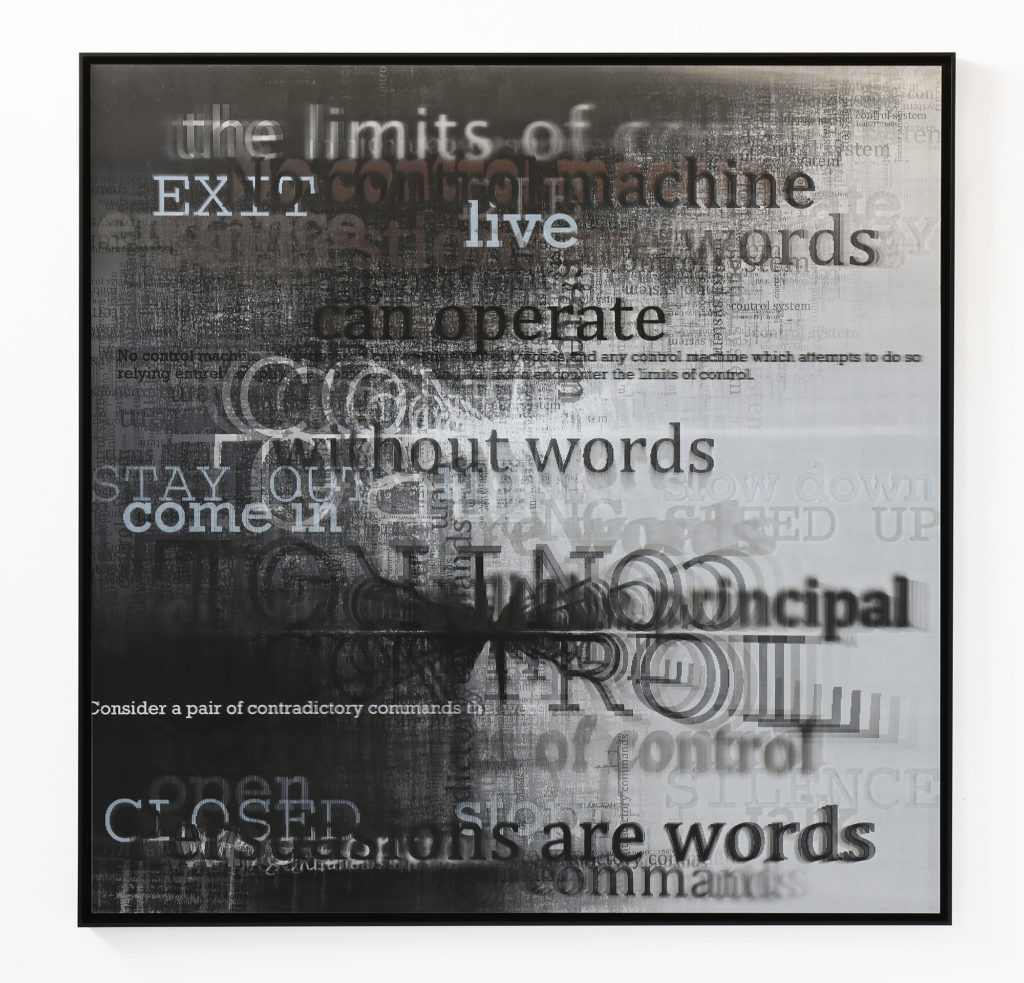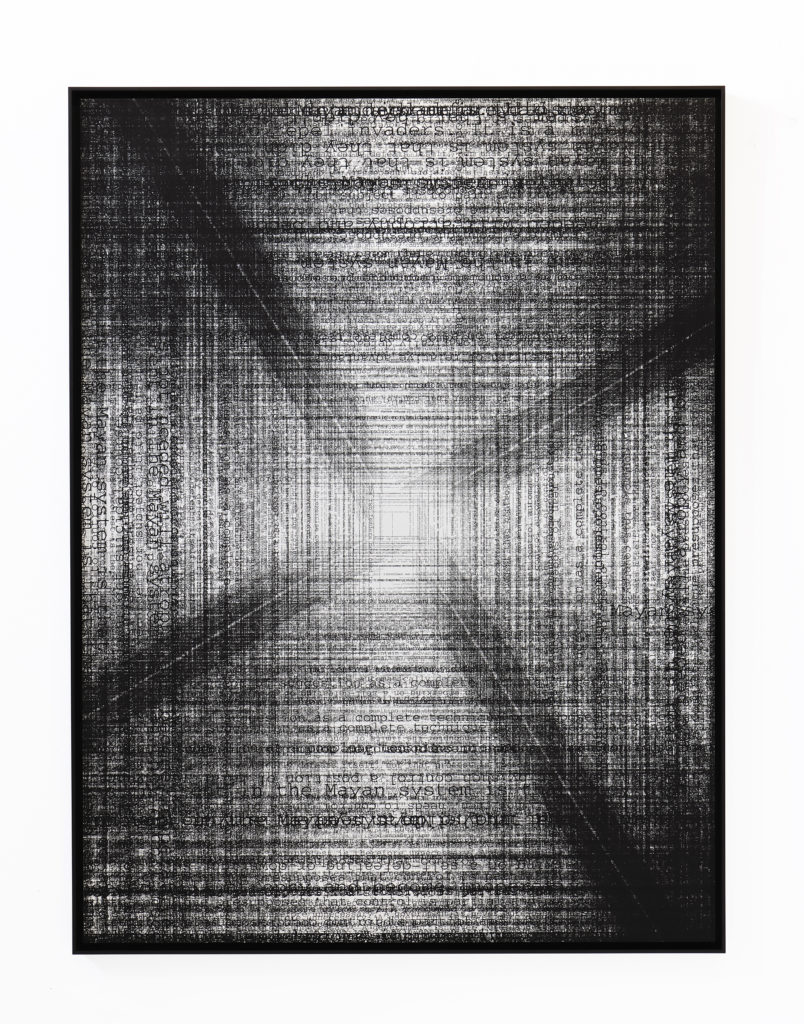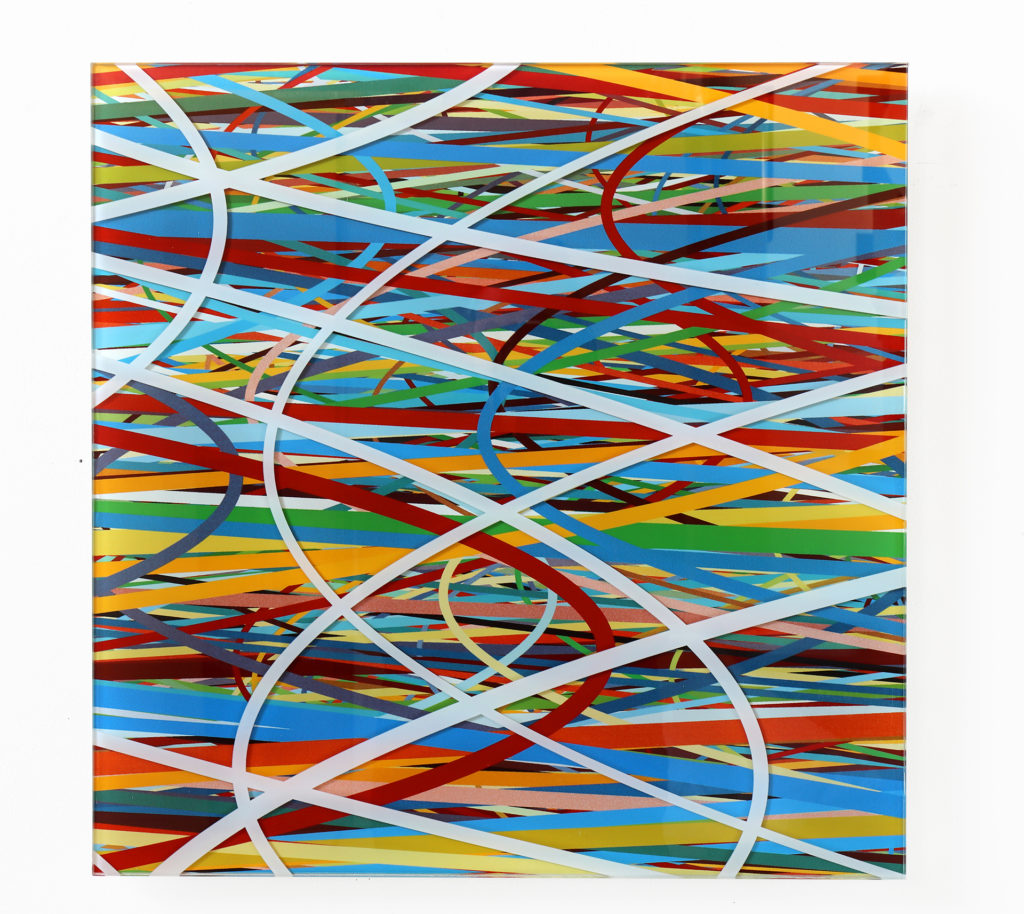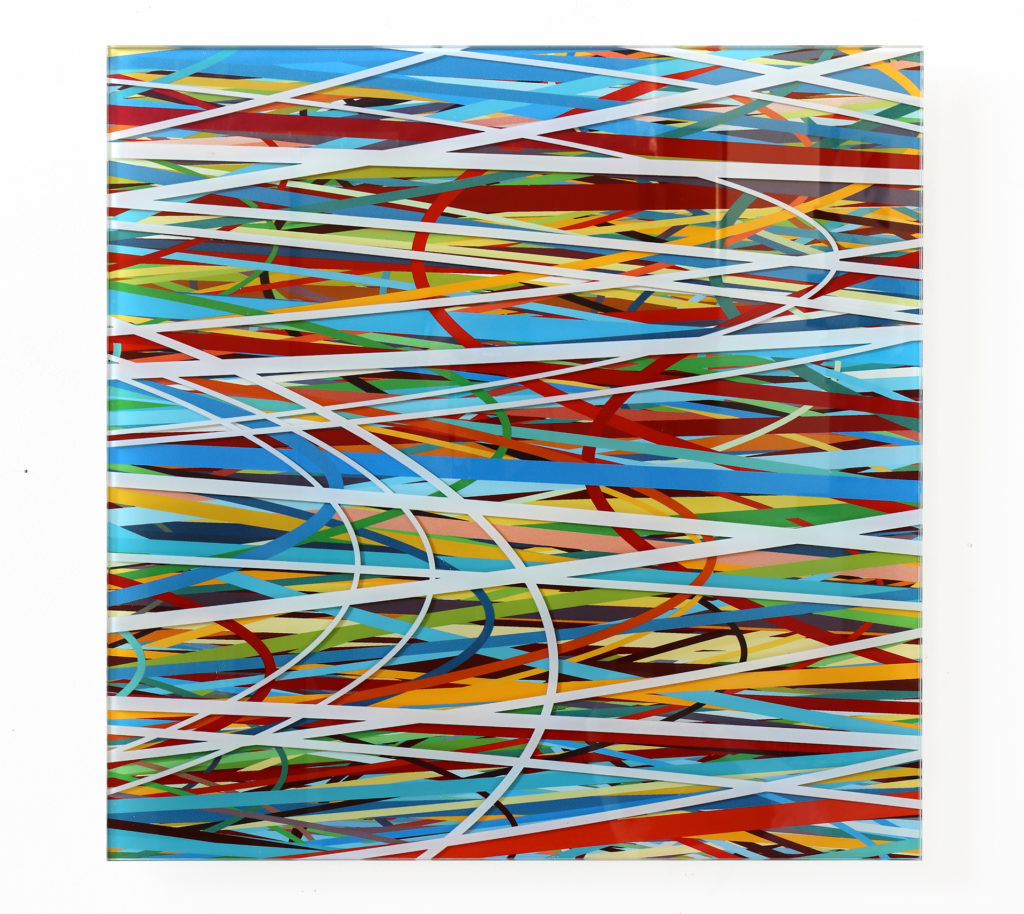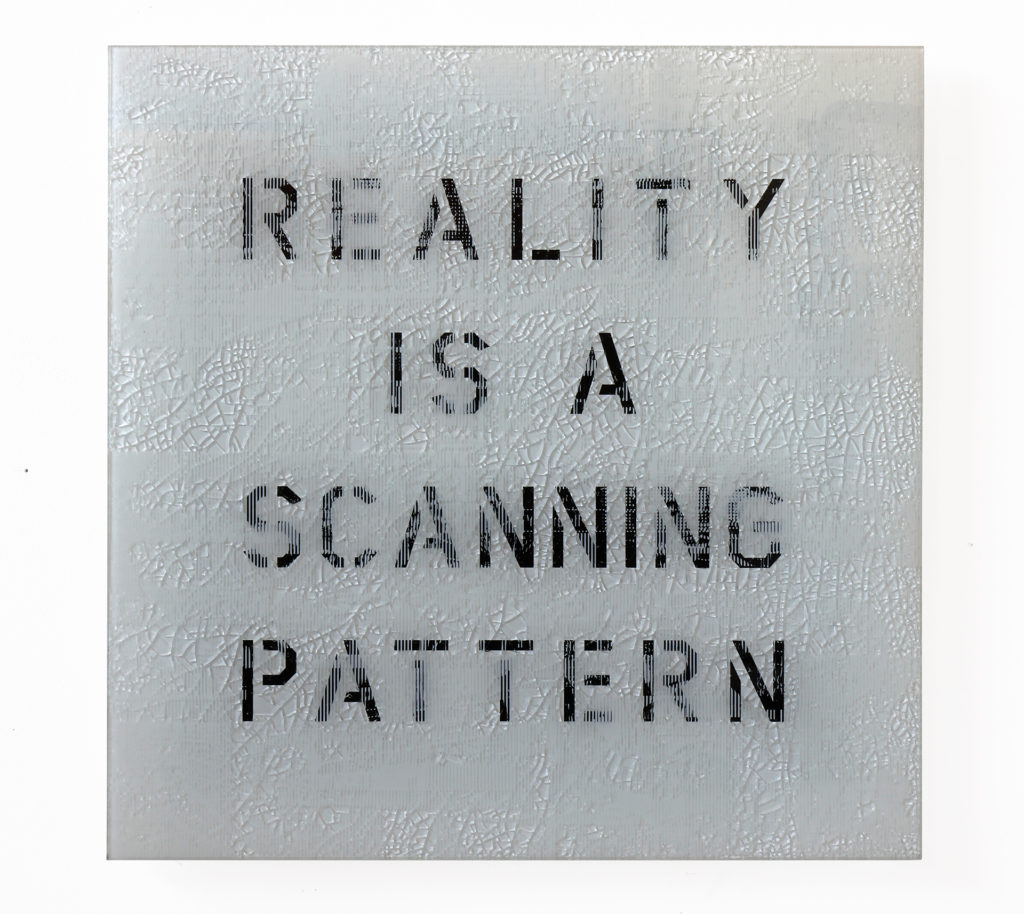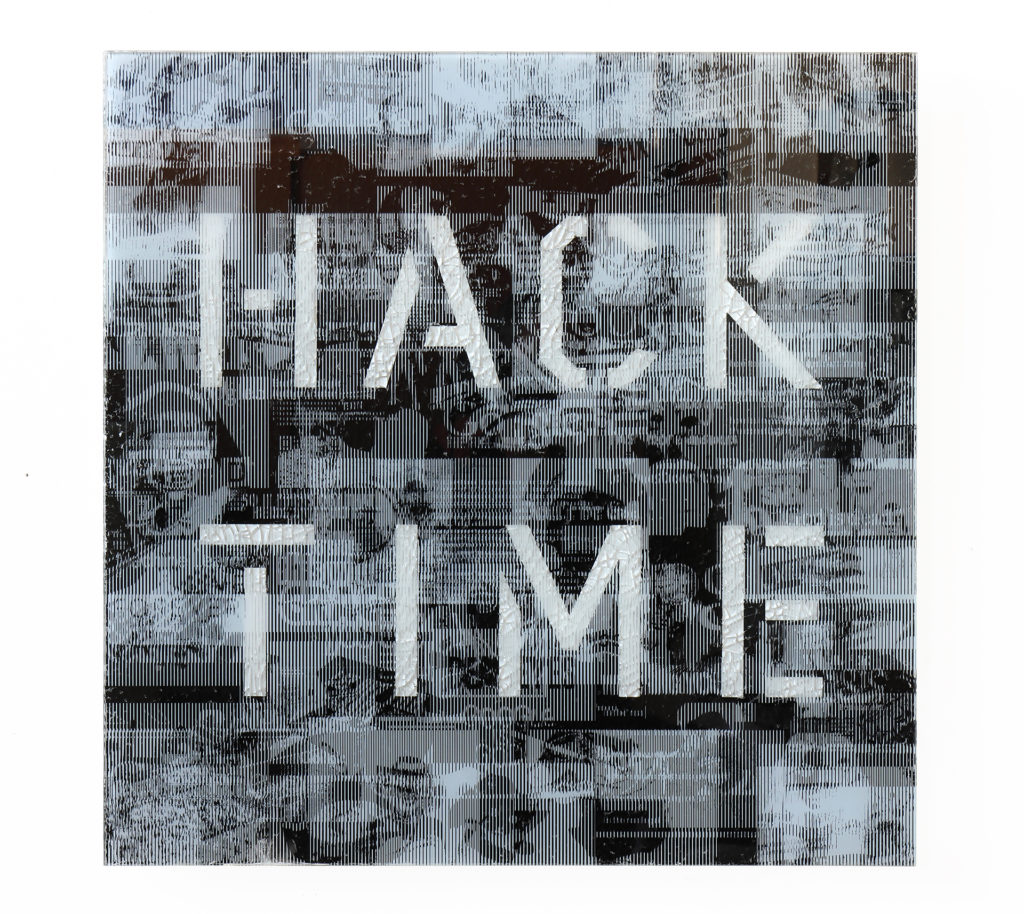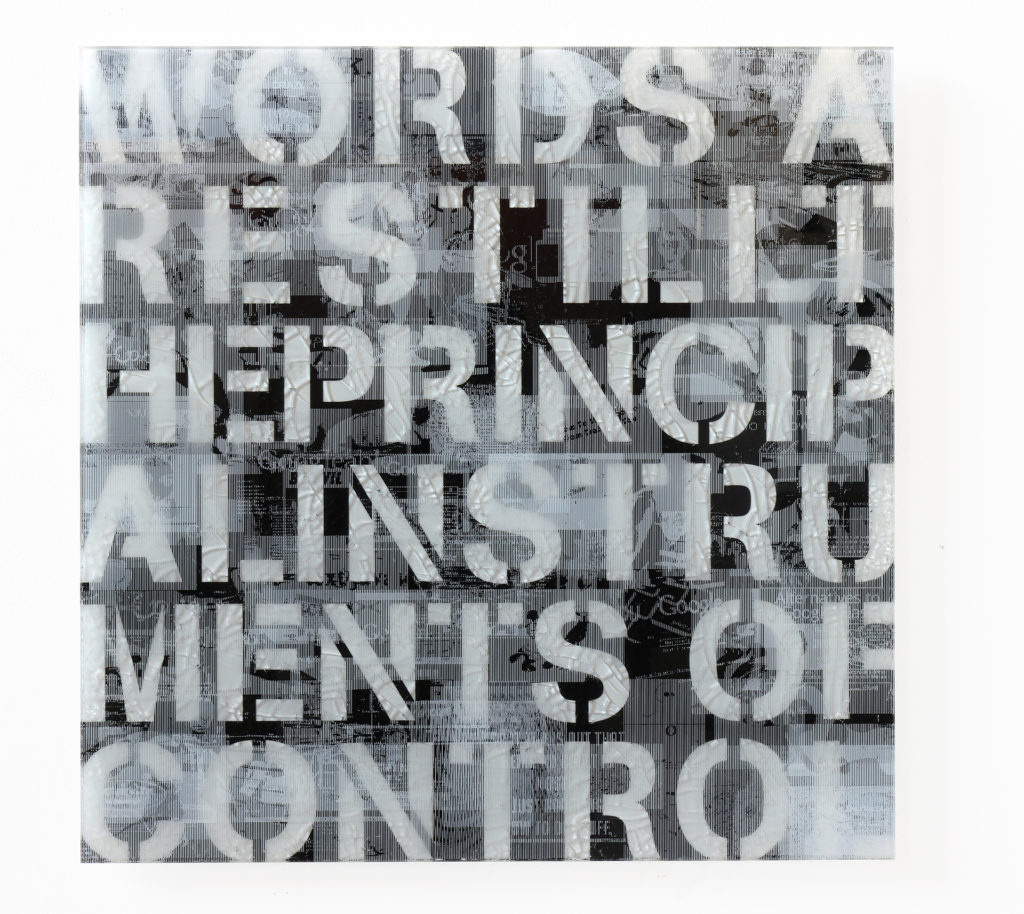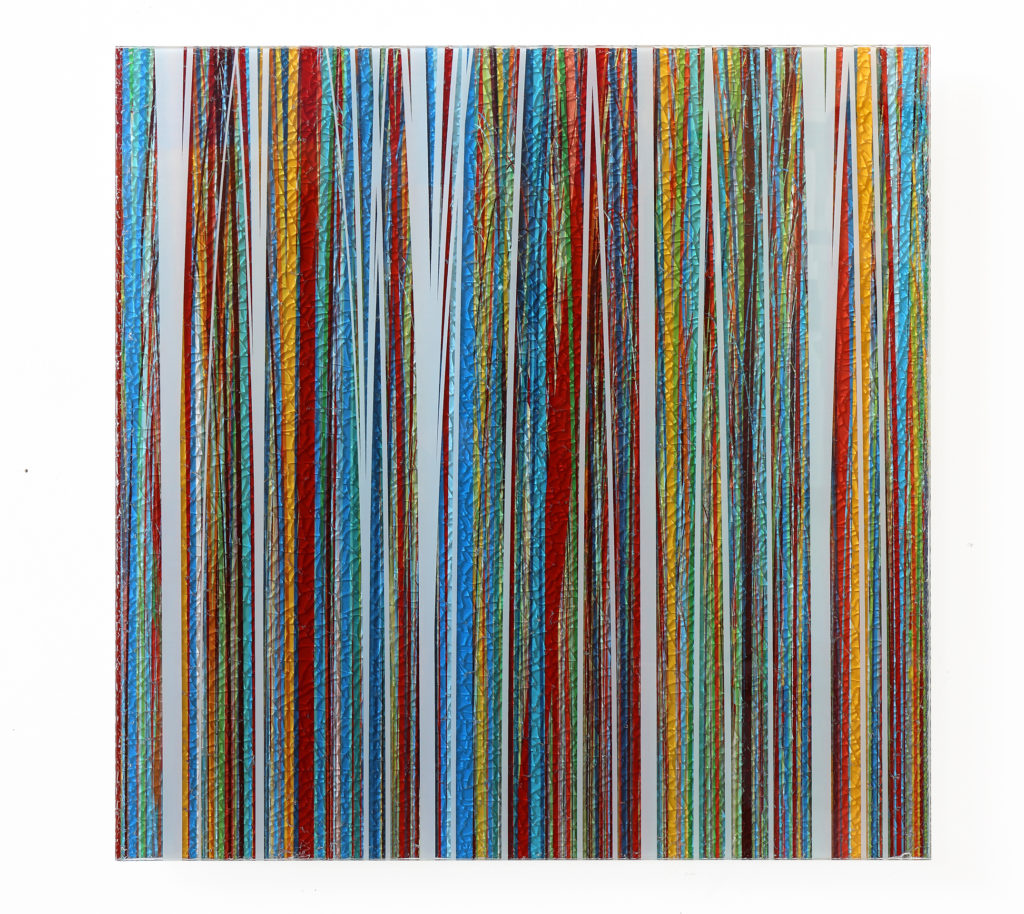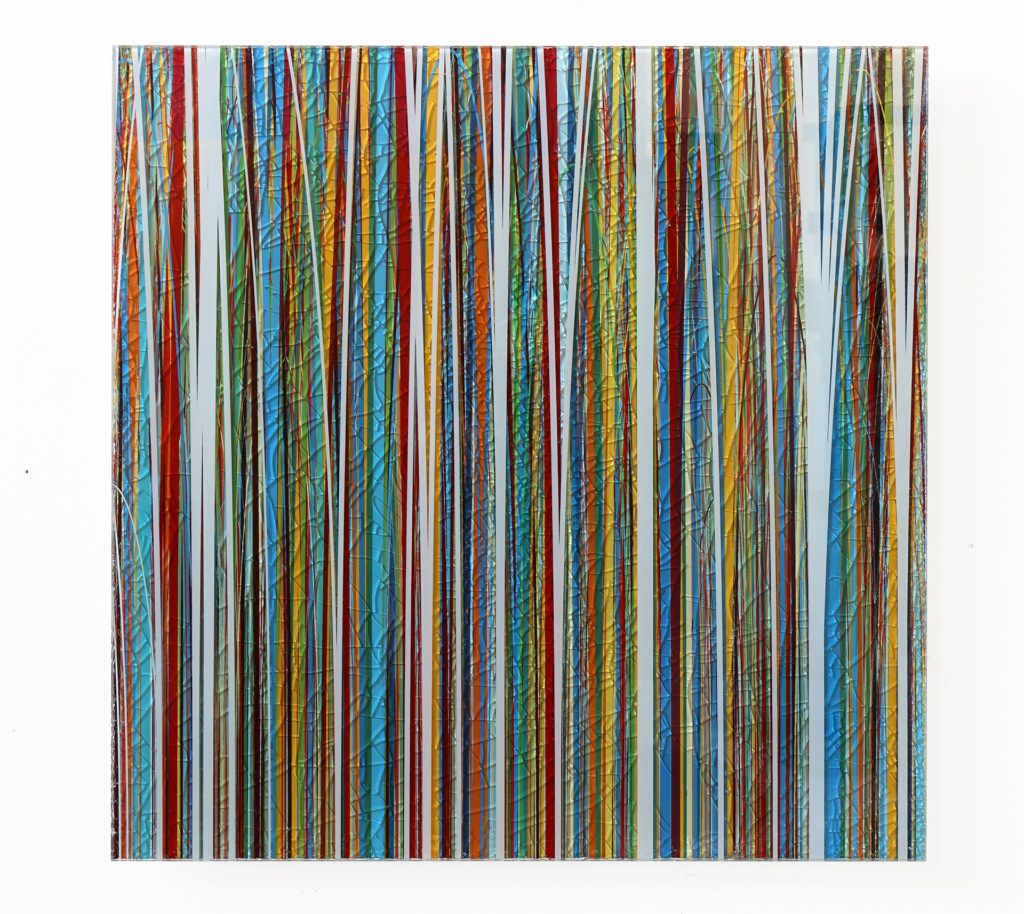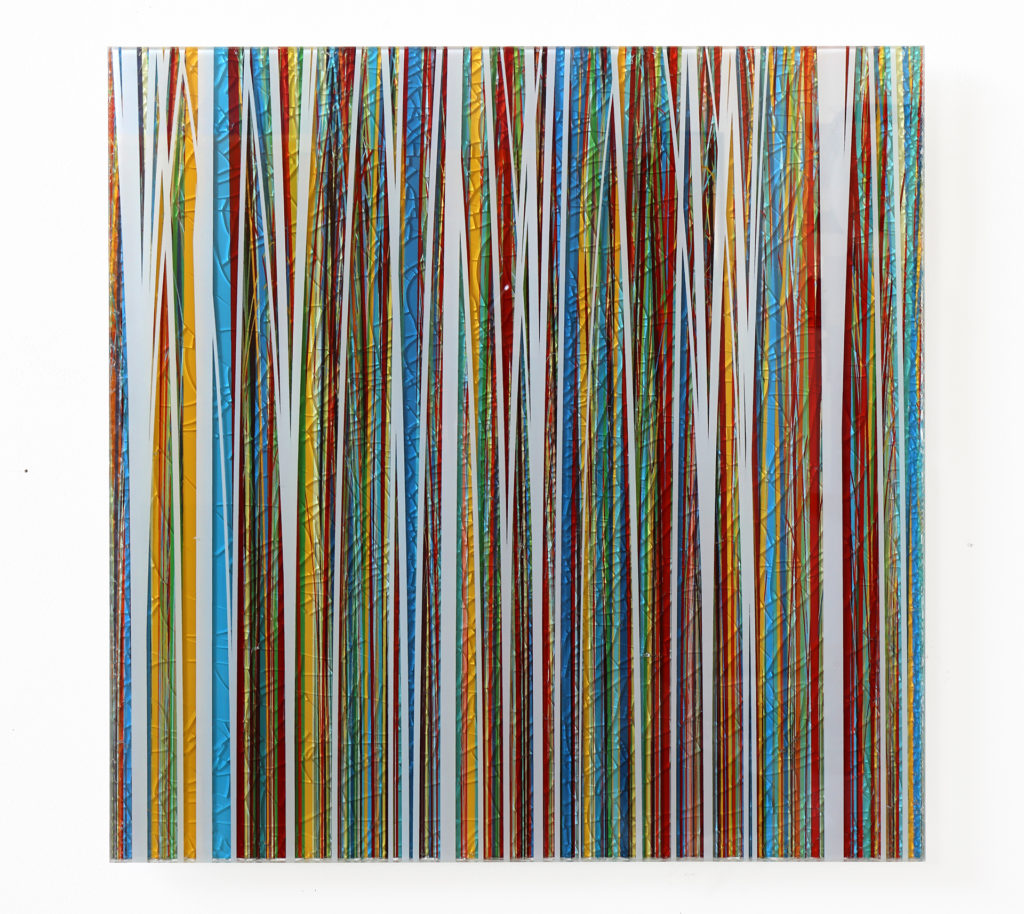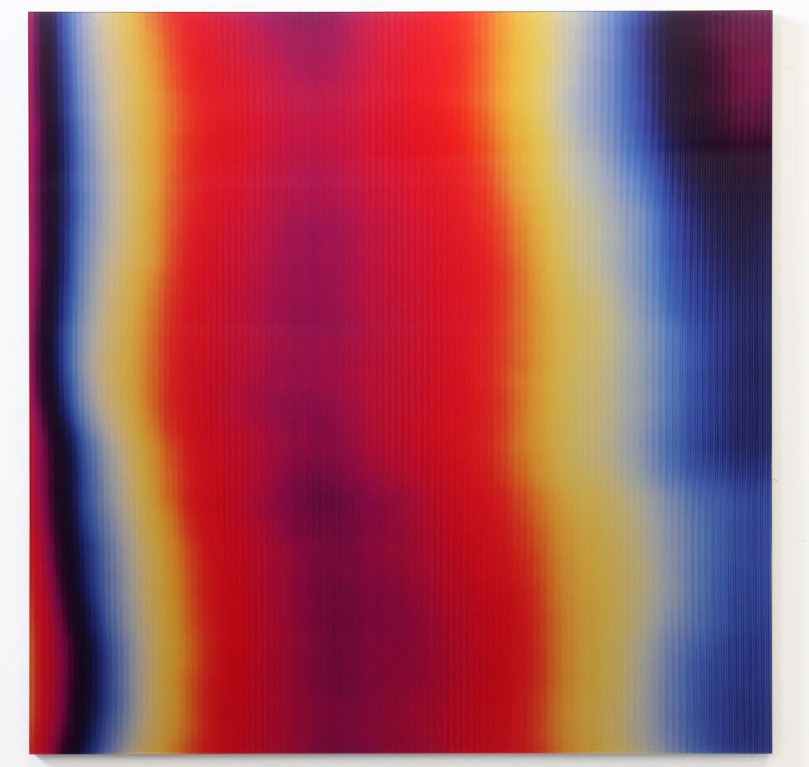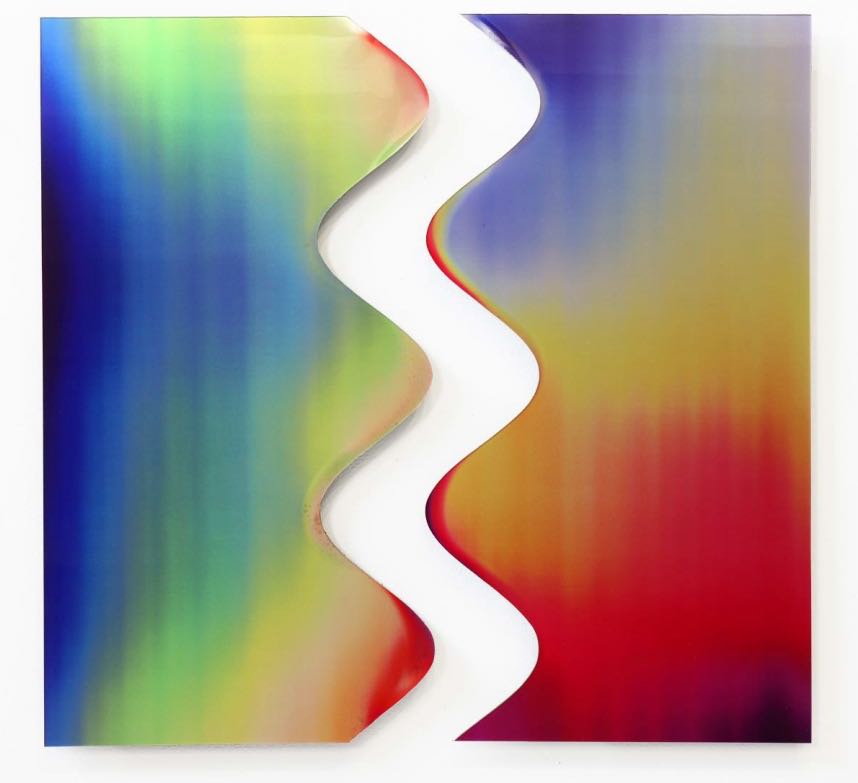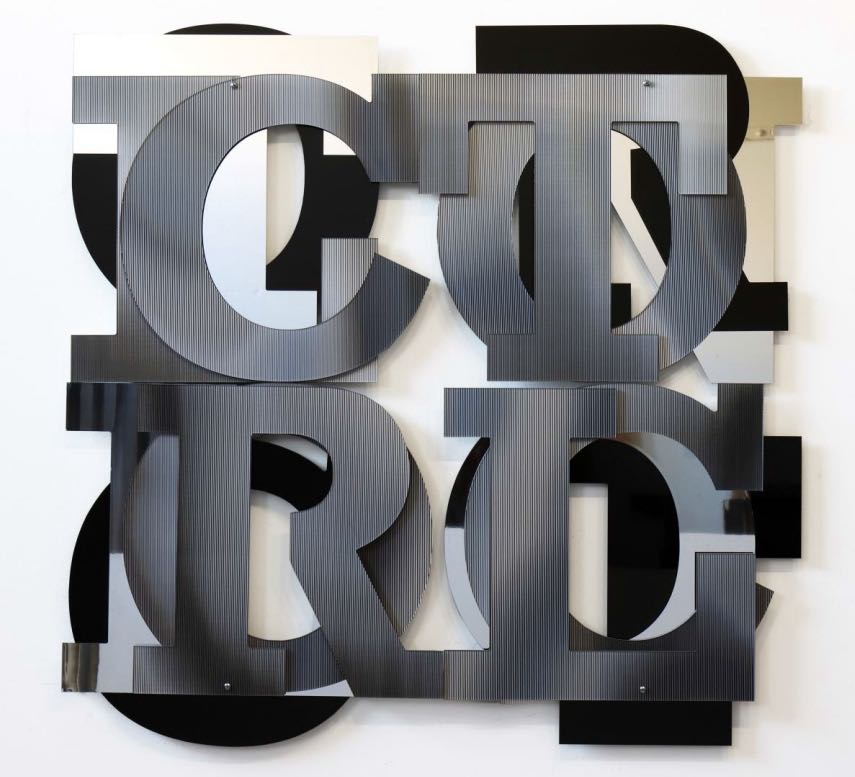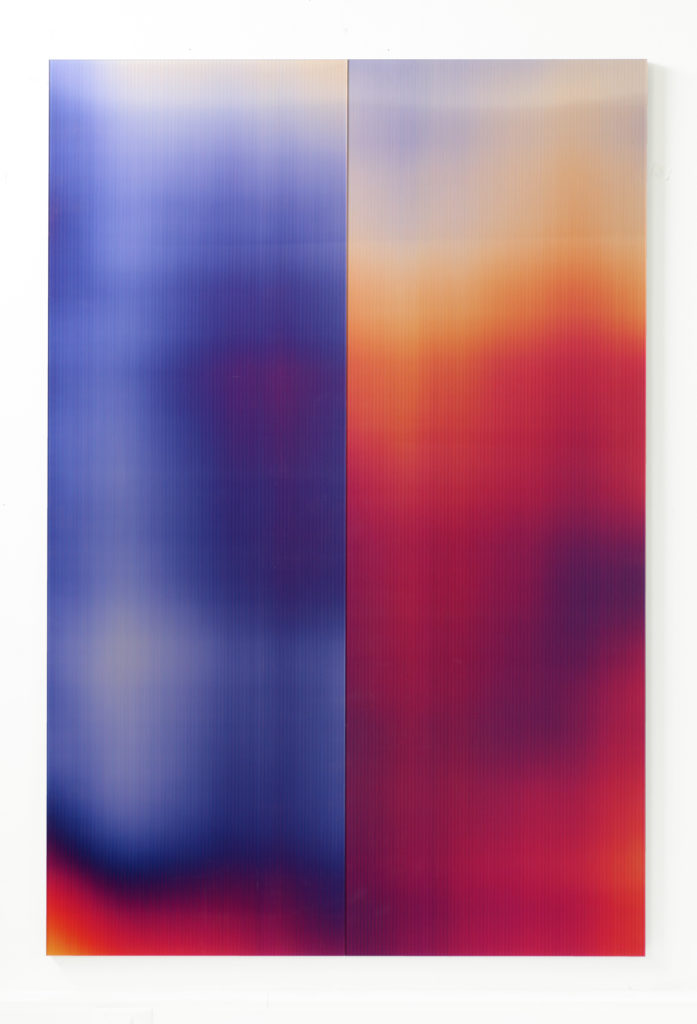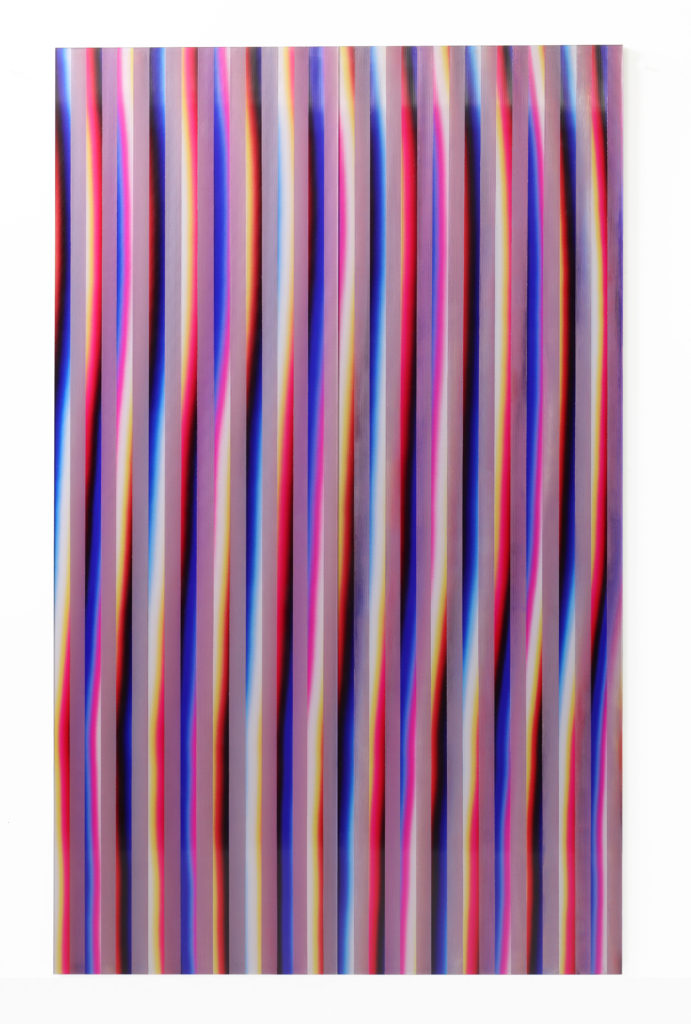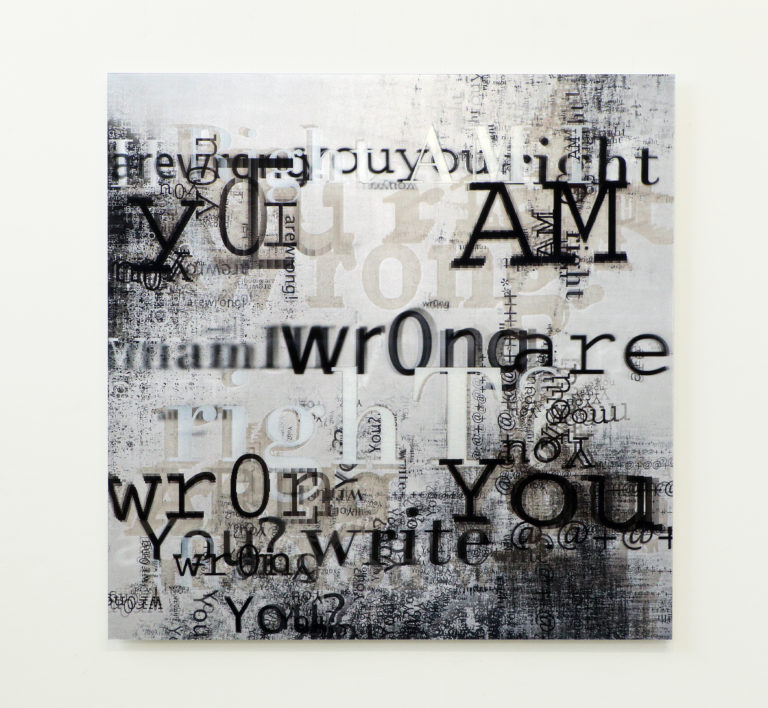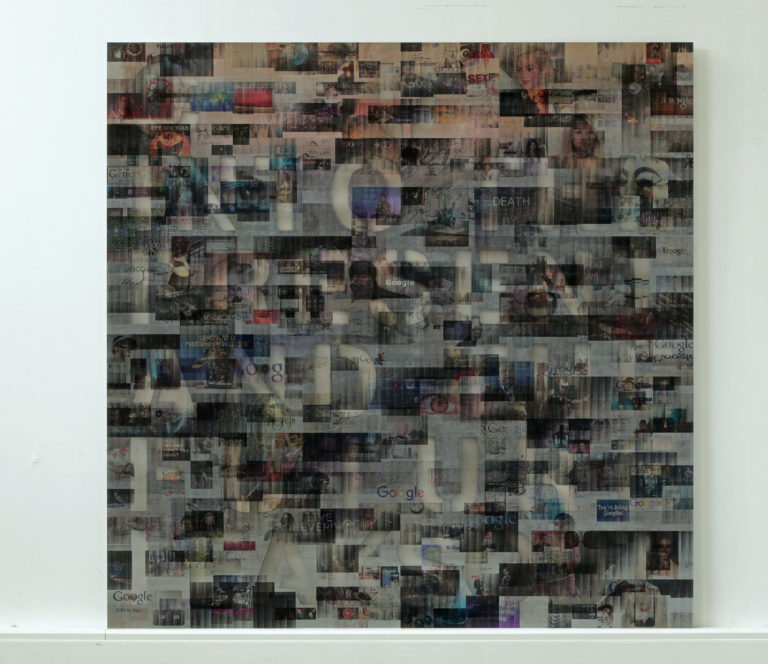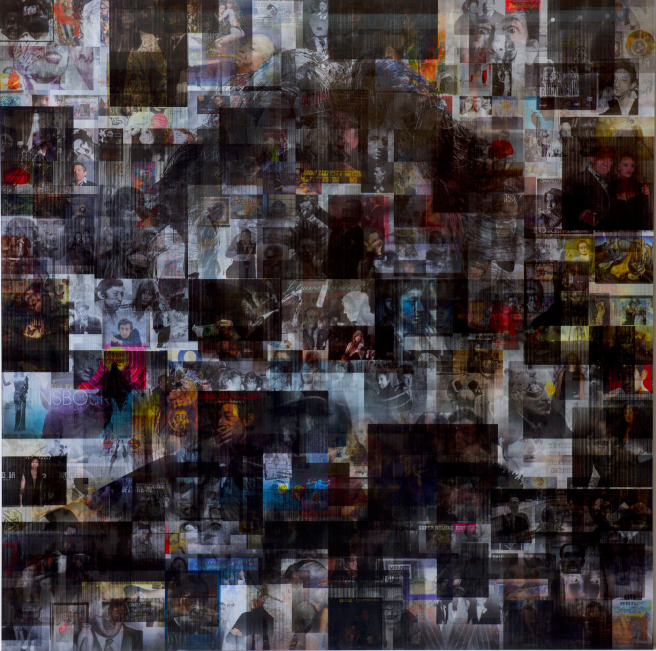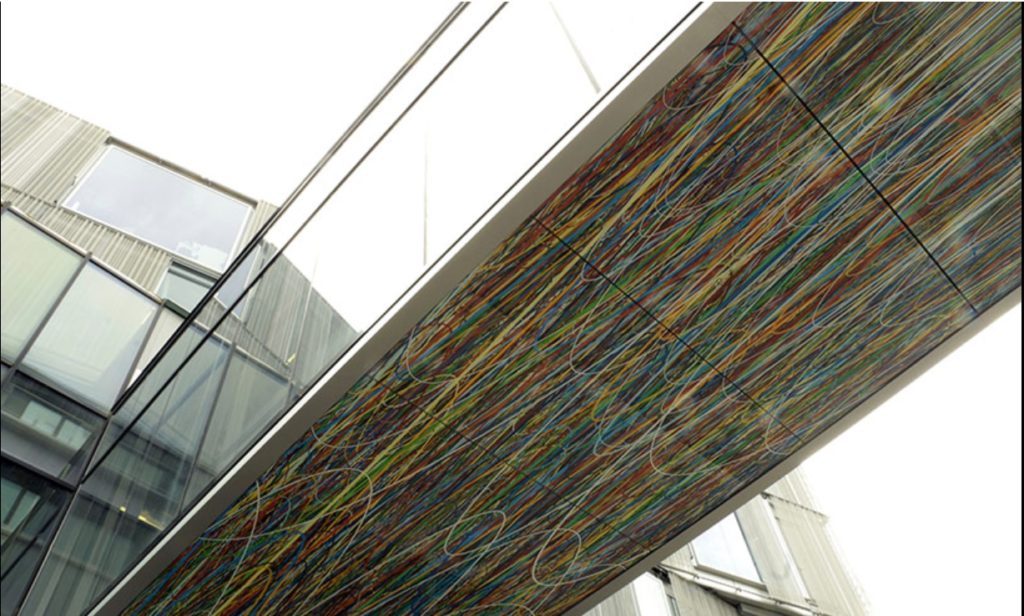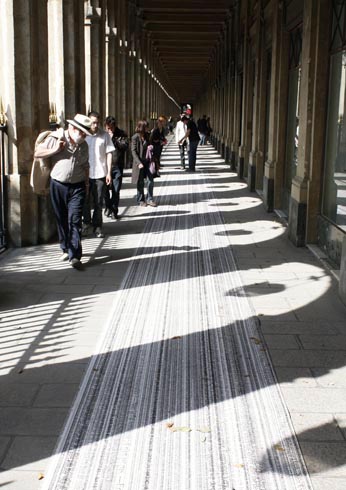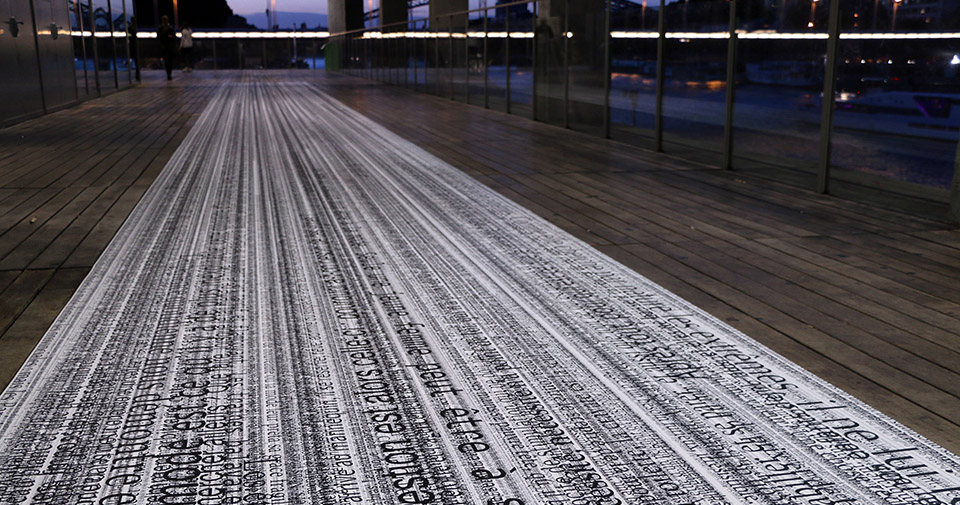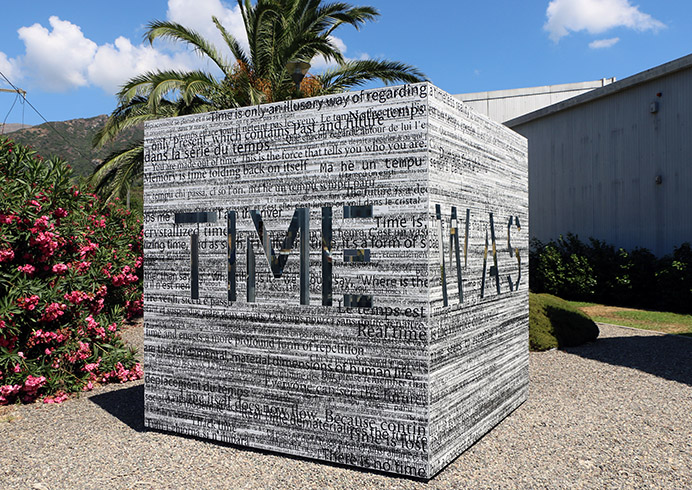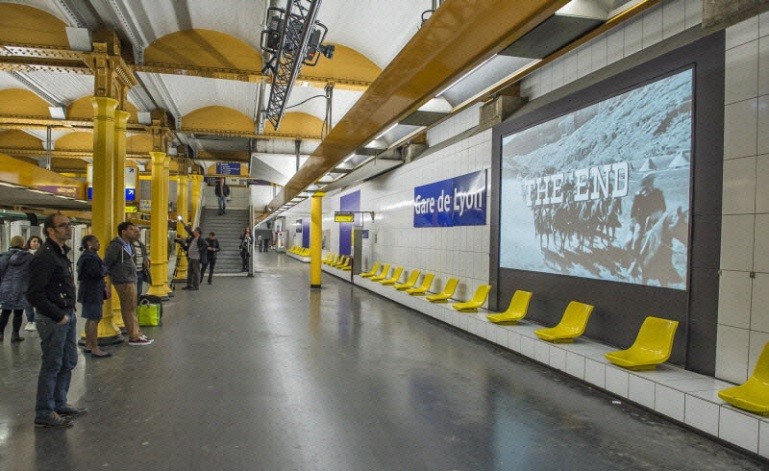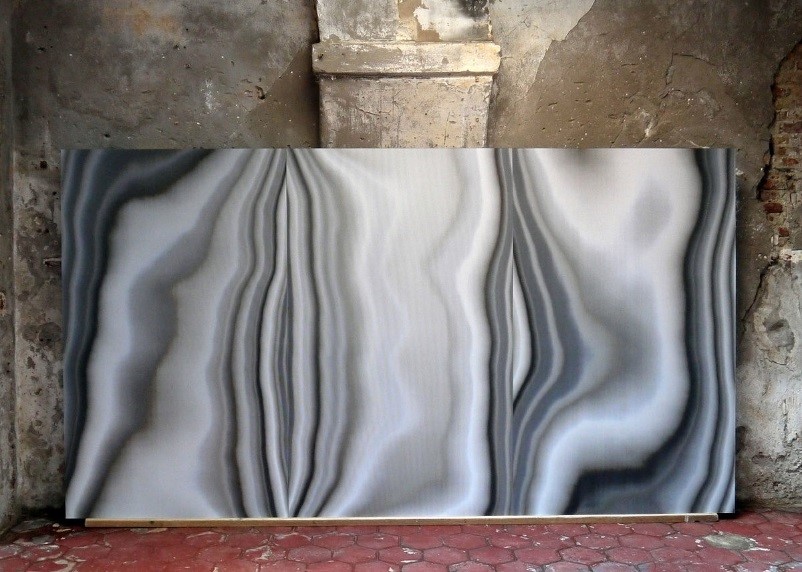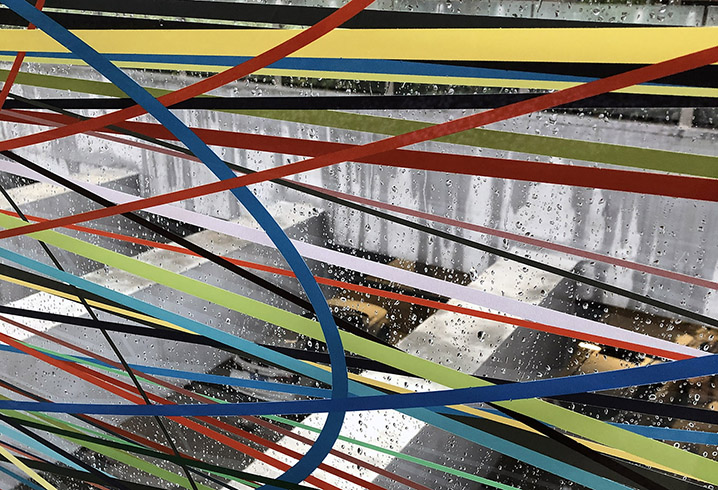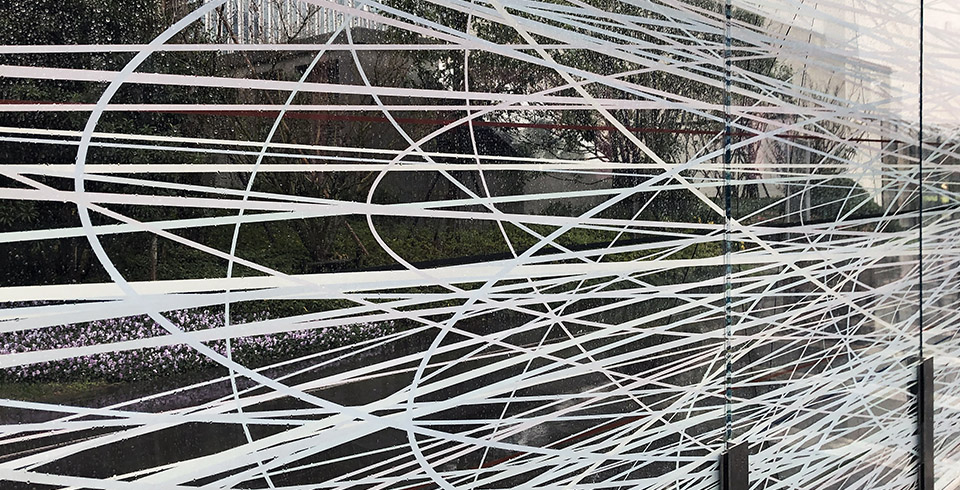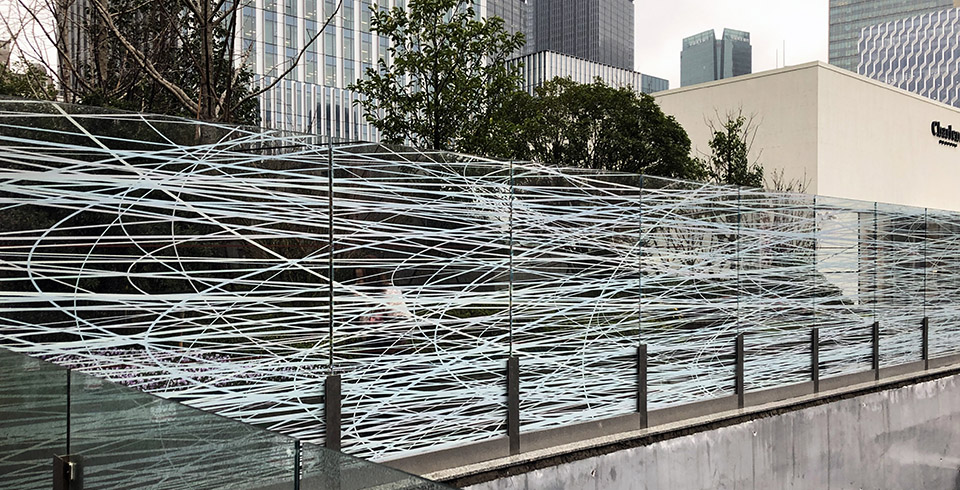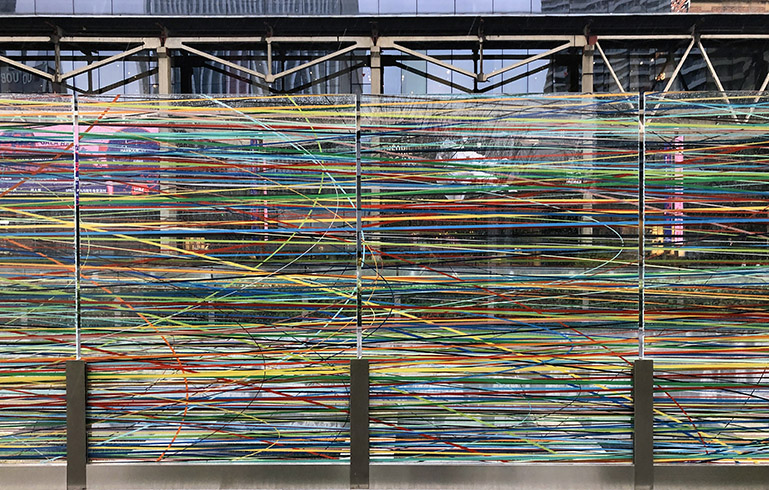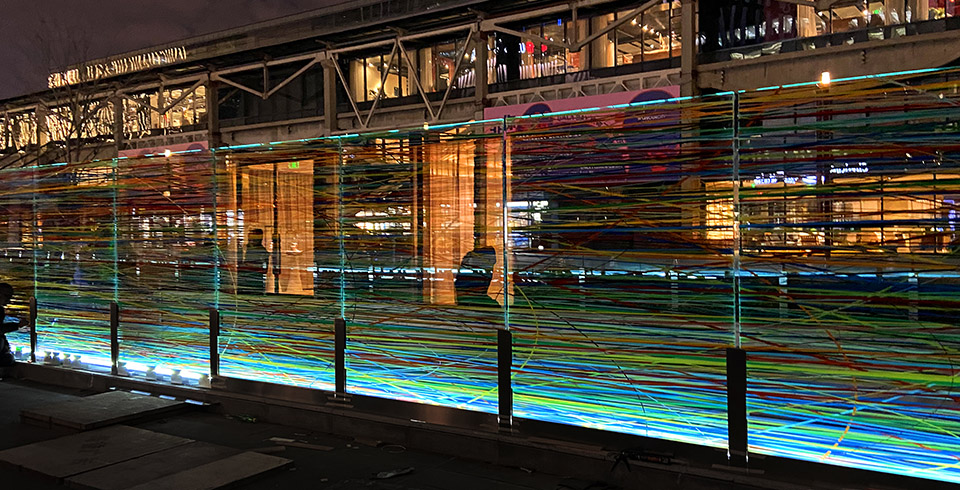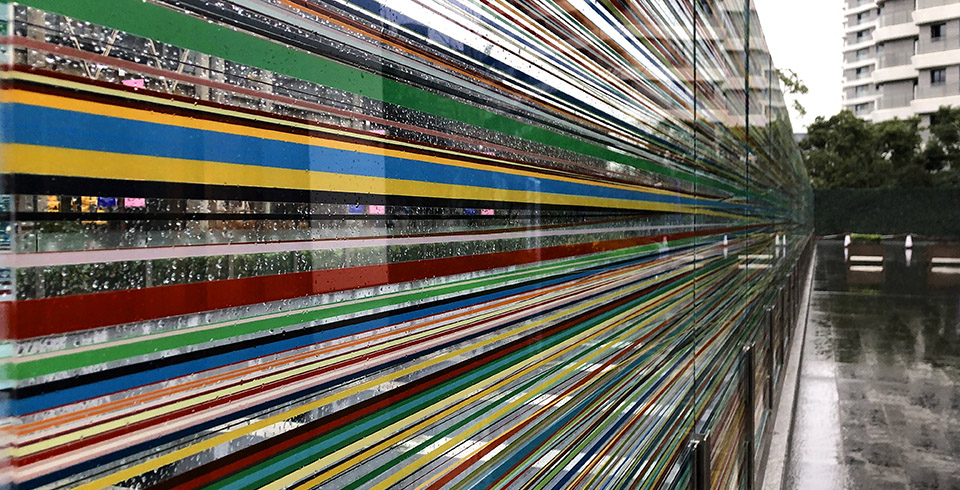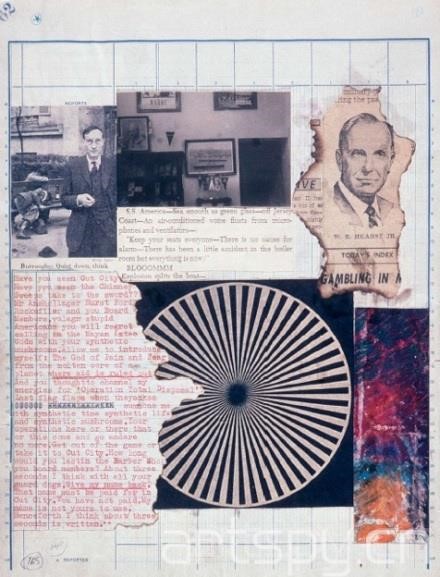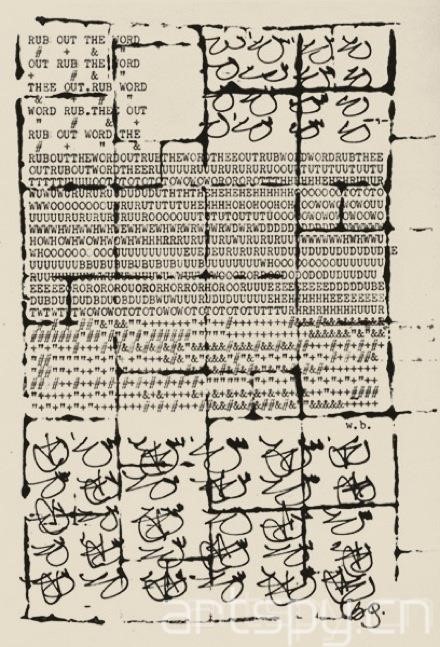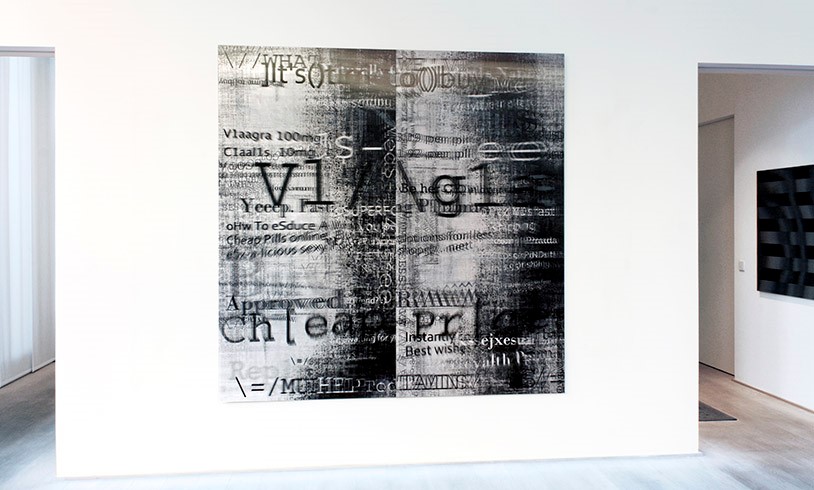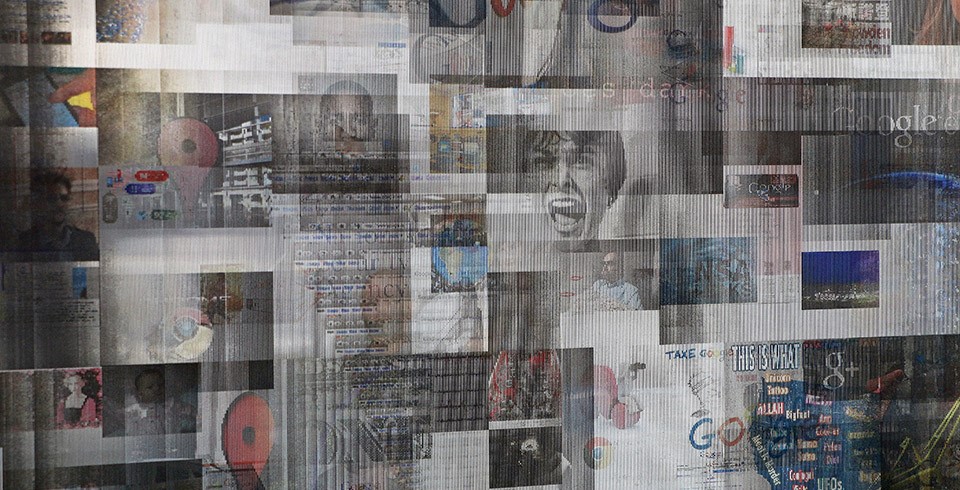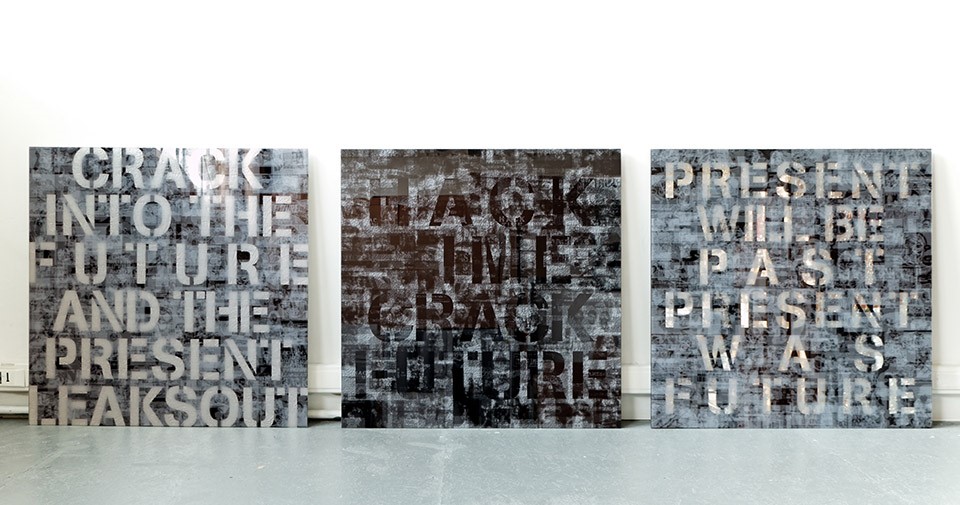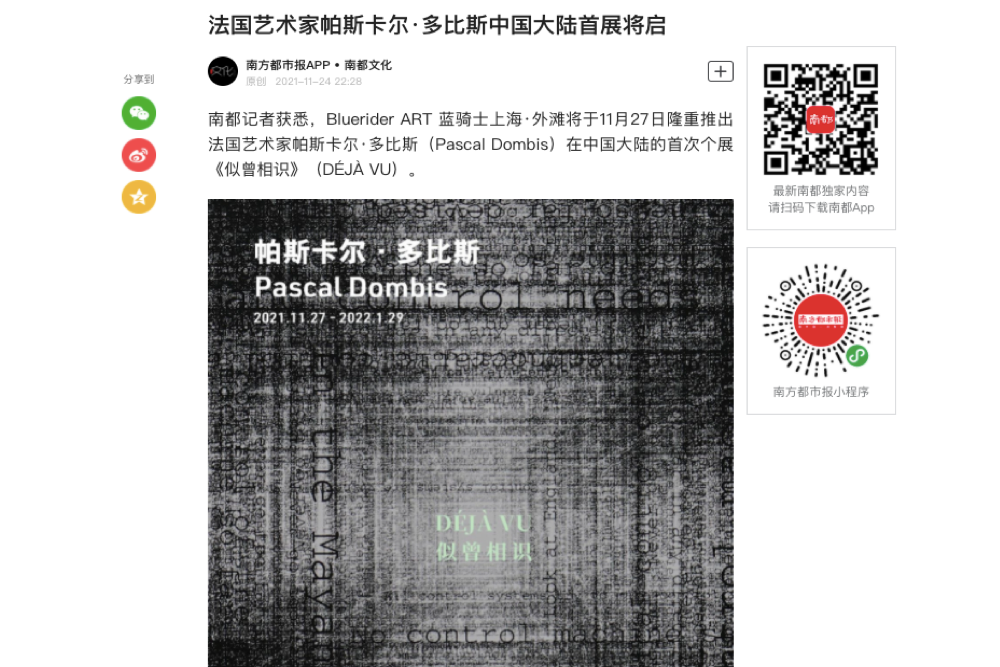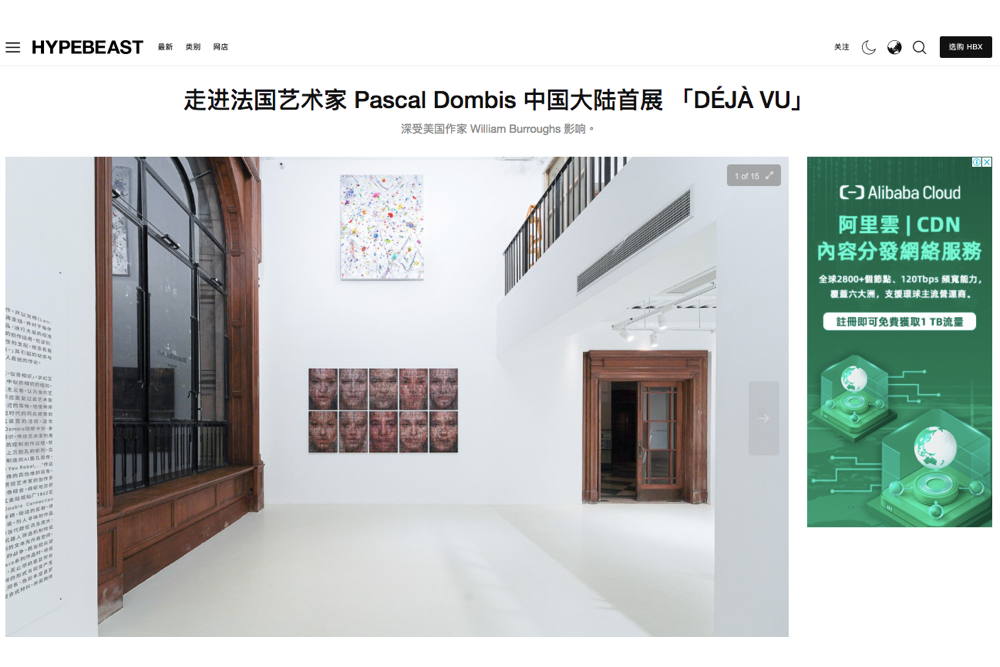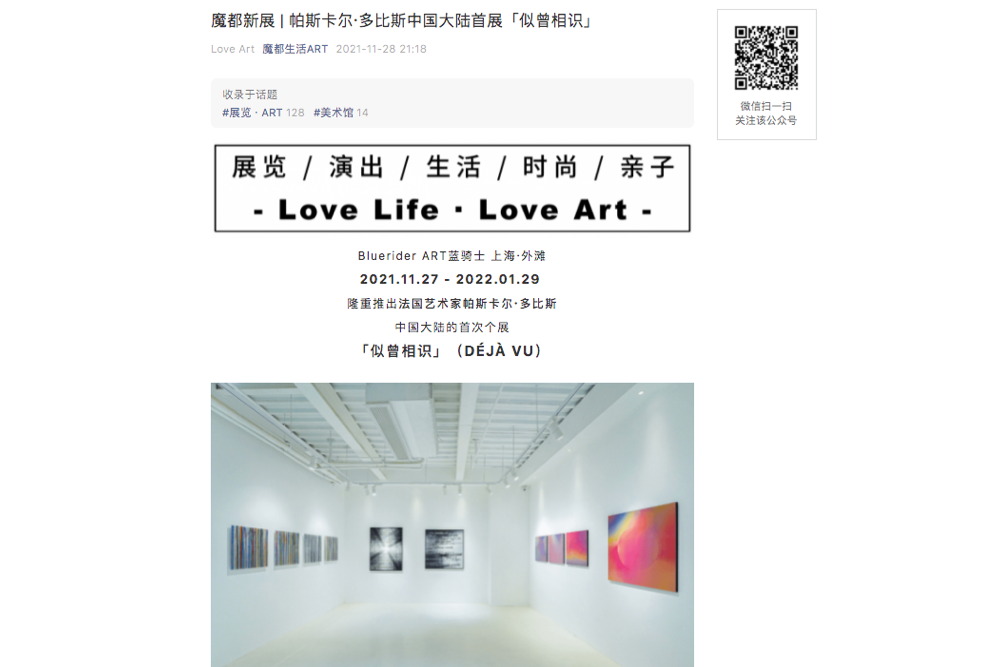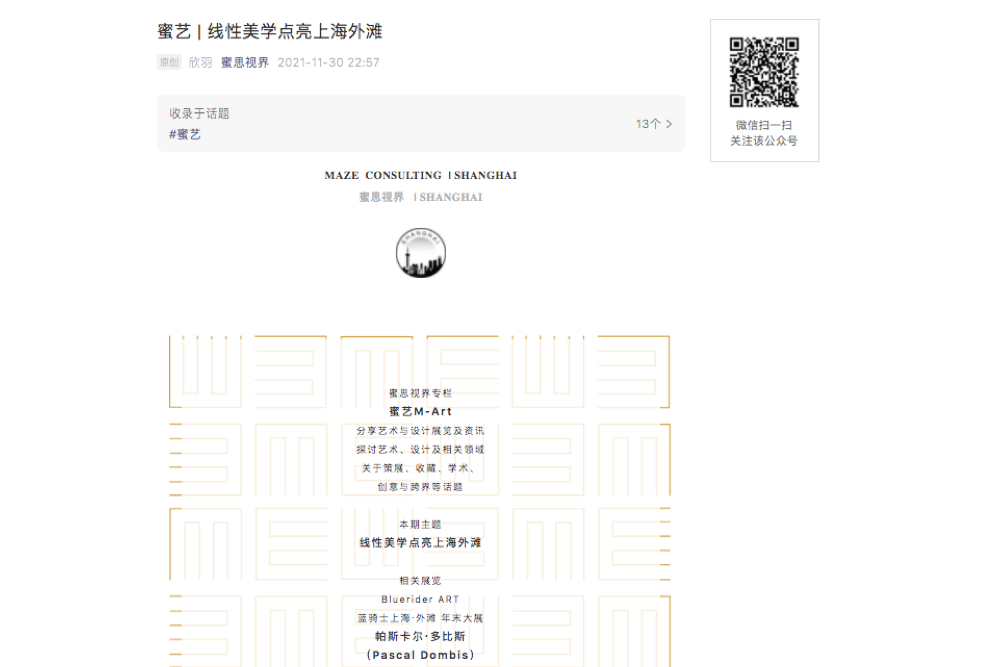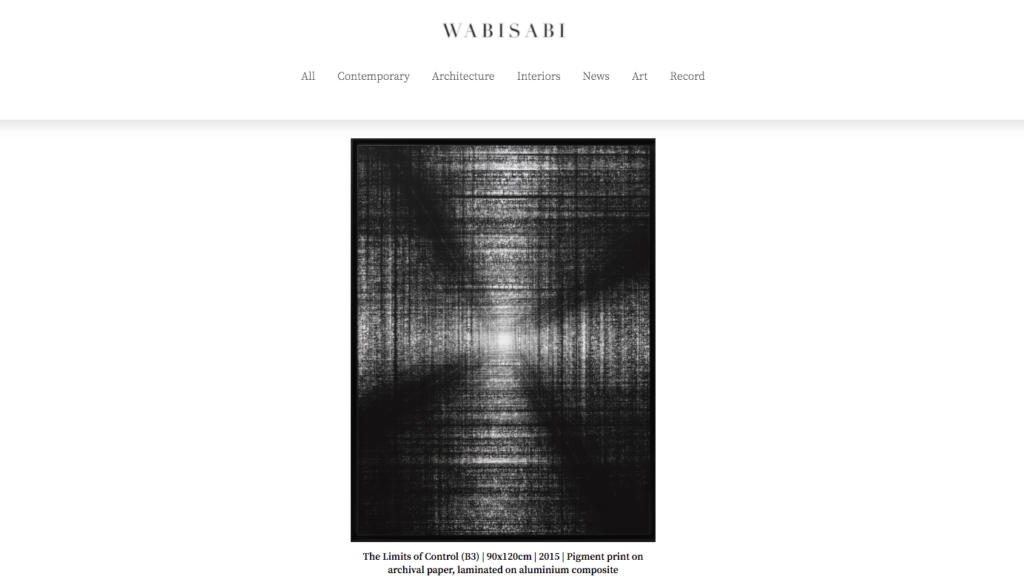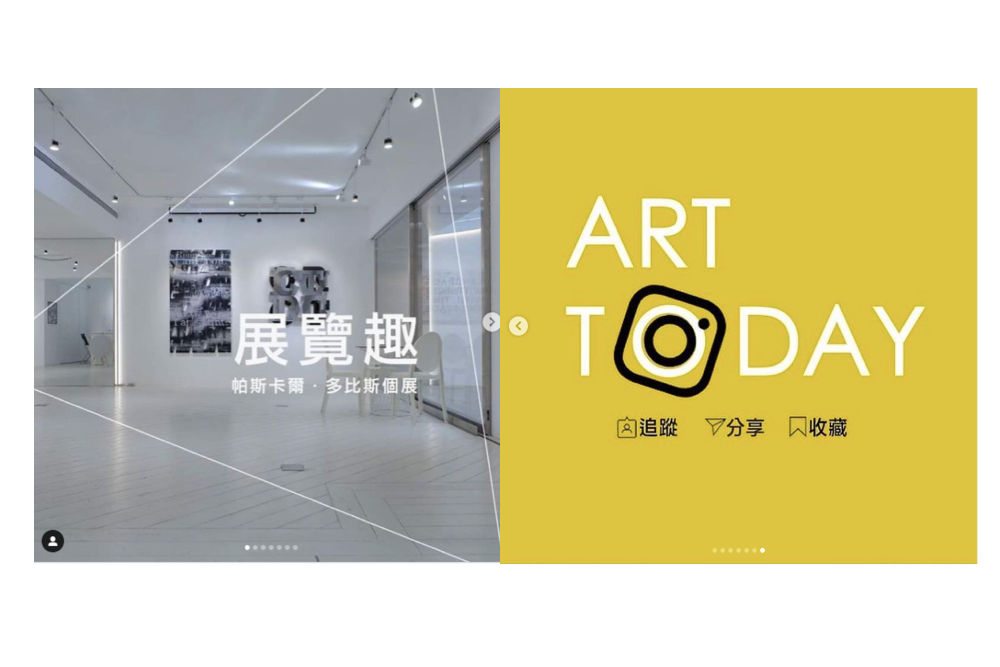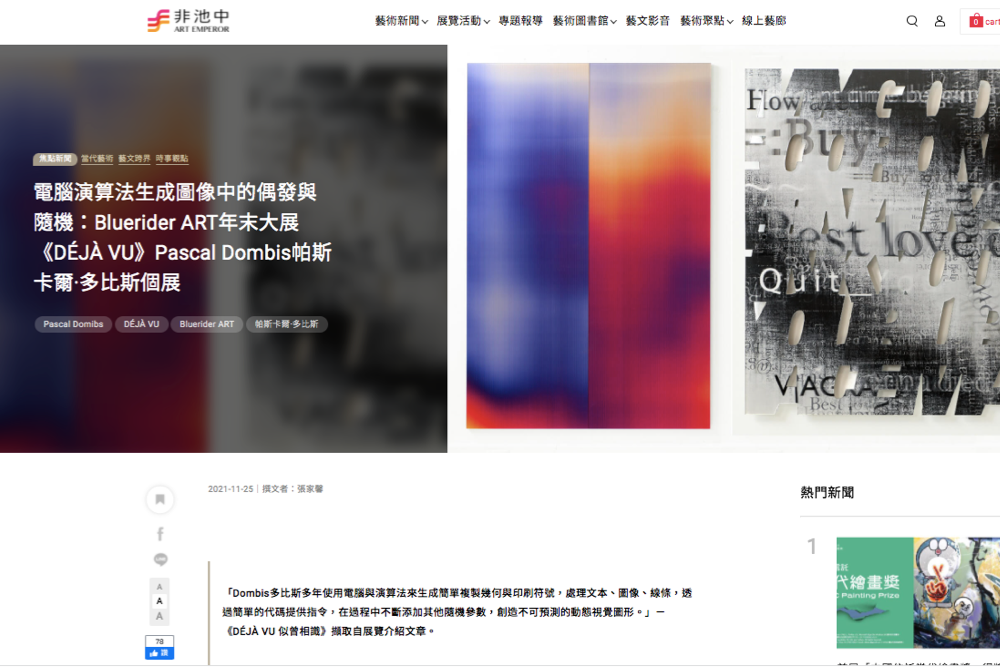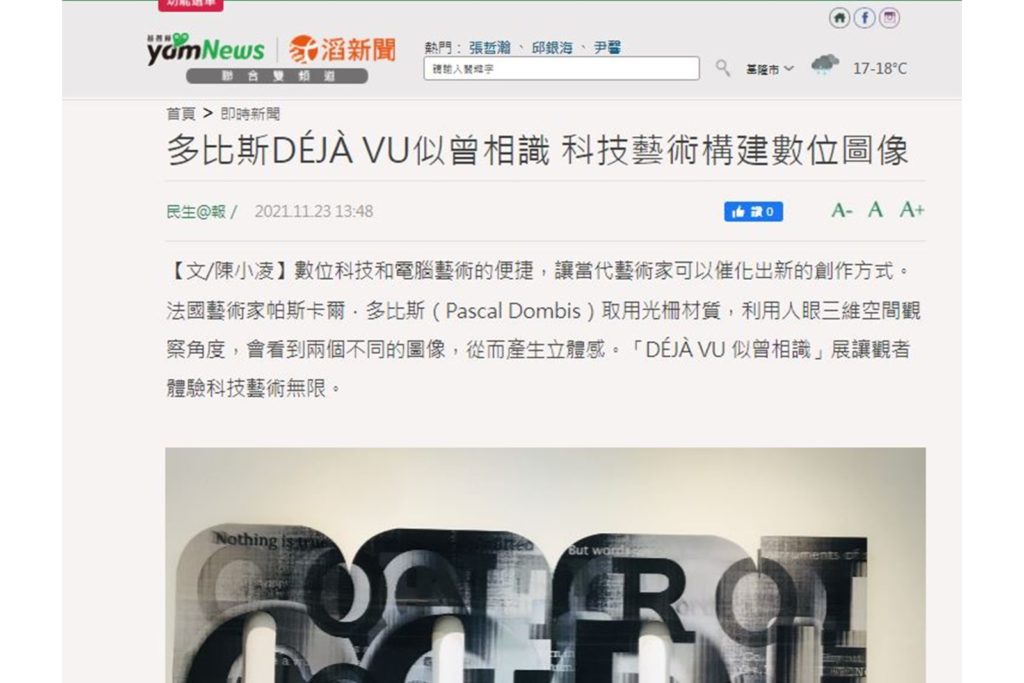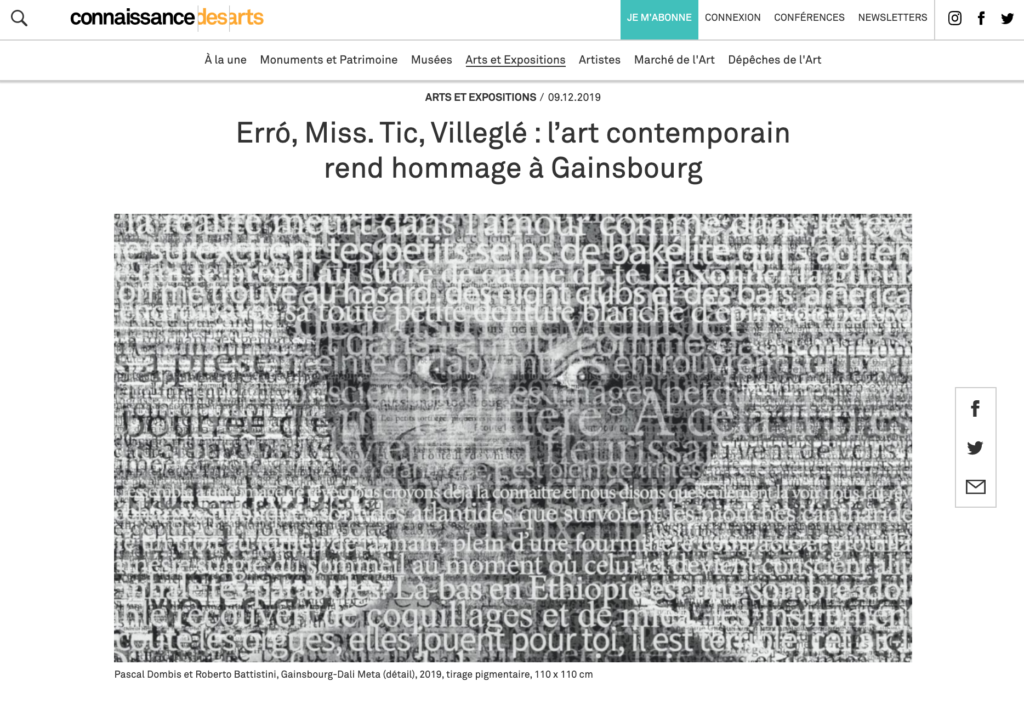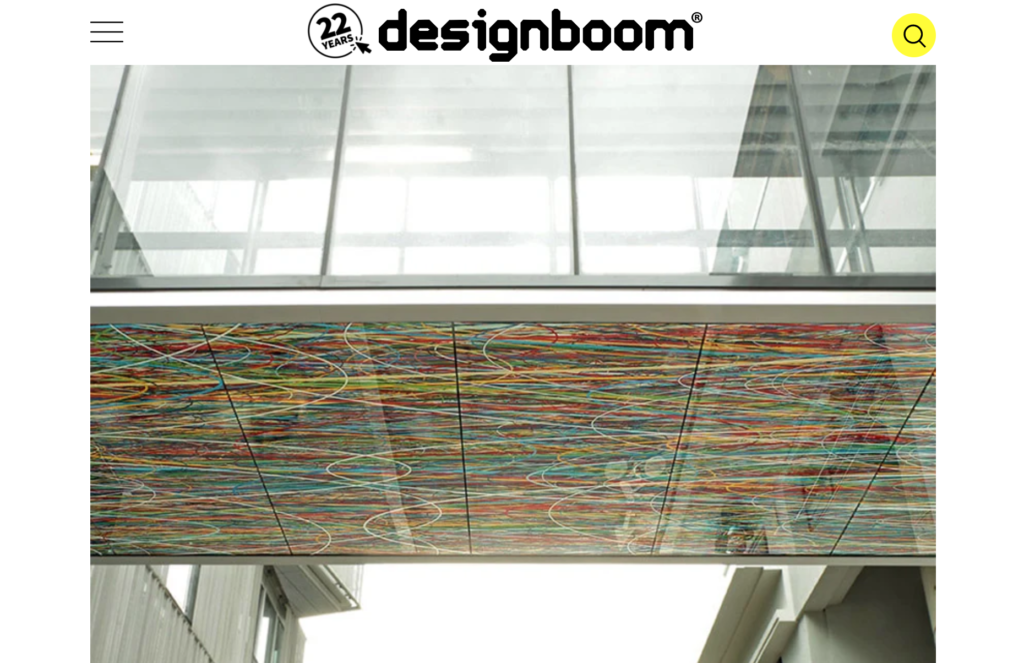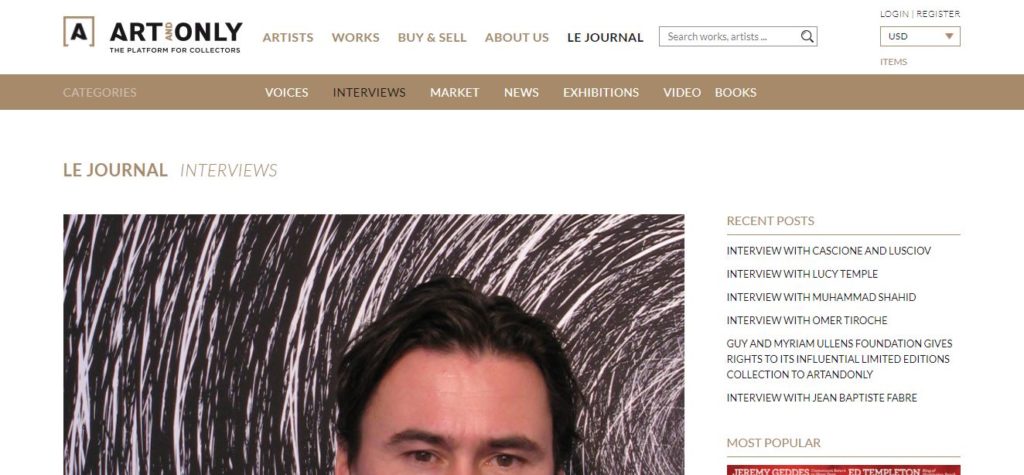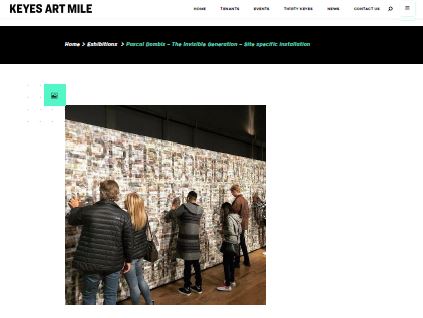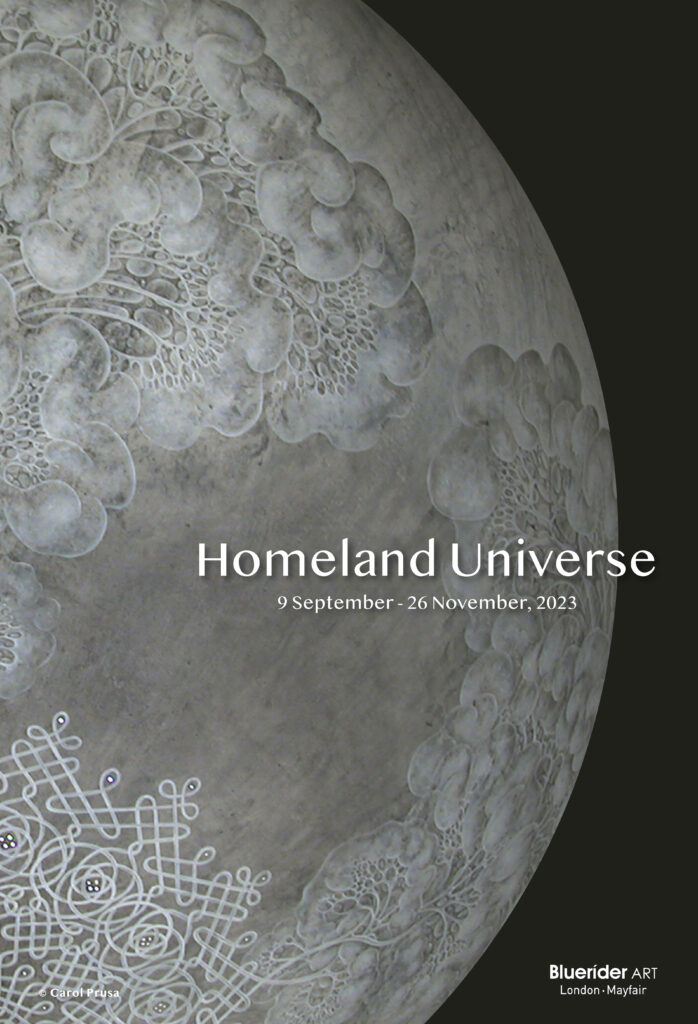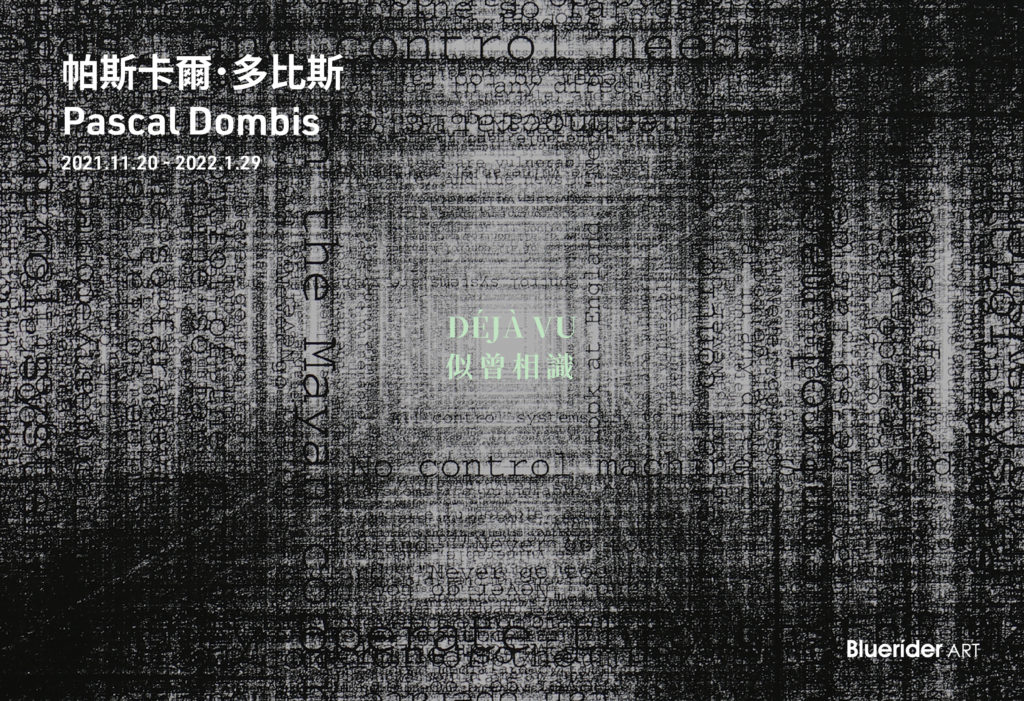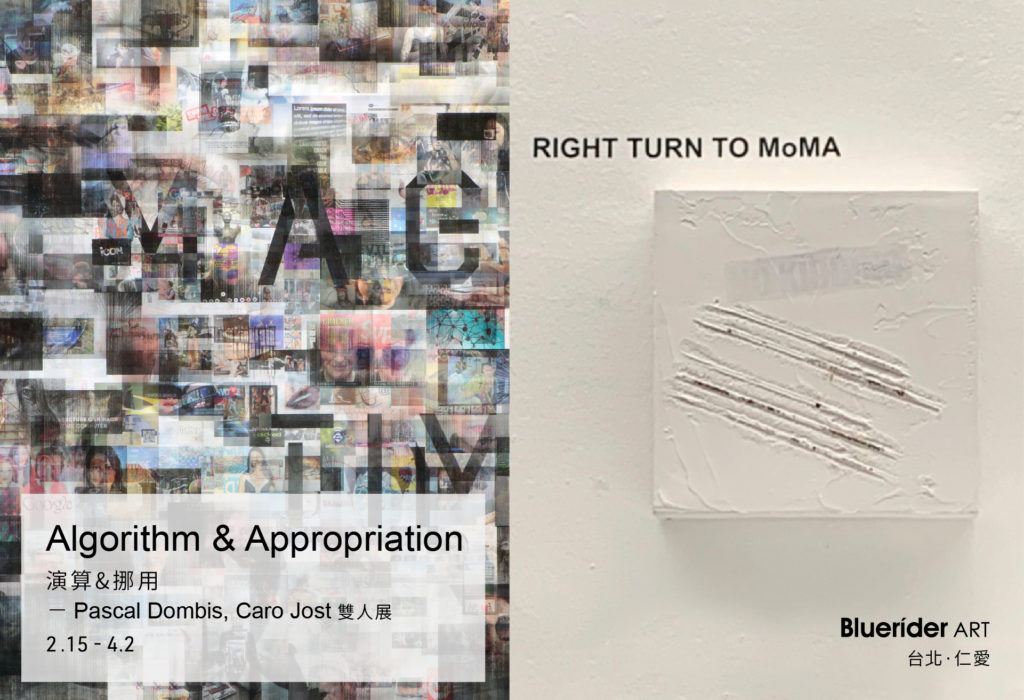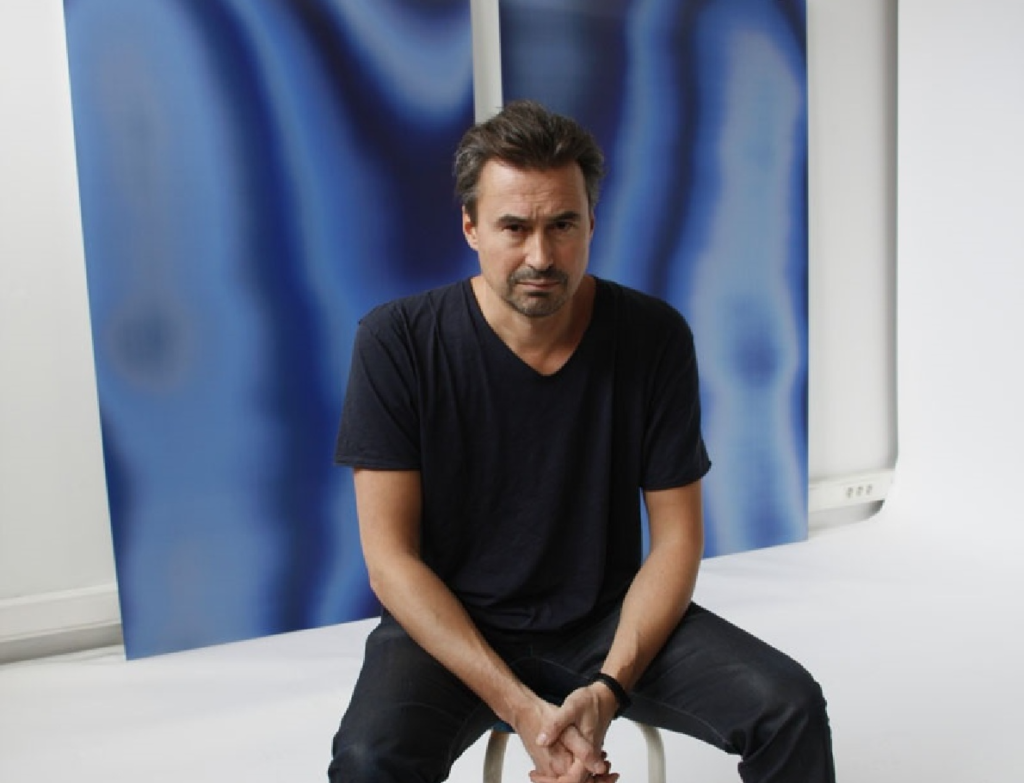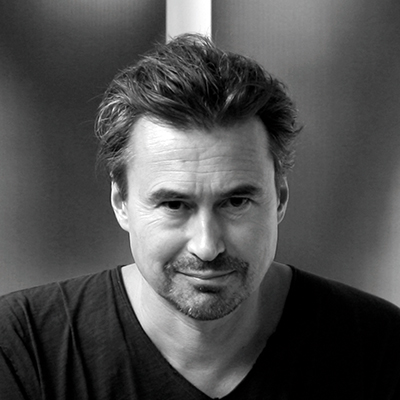

(France, b. 1965)
Graduated from Tufts University computer art and Insa University in Lyon, France. Digital artist Pascal Dombis currently lives and works in Paris. Dombis identifies himself as a modernist, creating visually captivating paradoxes through his dynamic and unpredictable presentations. Influenced by American writer William S. Burroughs, Dombis explores the liberation of text by randomly cutting linear texts into different parts and reassembling them into a new, unpredictable, and illogical "text." By collecting huge database and using algorithms, Dombis has been creating geometric and printed symbols, manipulating text, images, and lines through simple code with added random parameters, resulting in dynamic visual graphics. He considers "chance" and "randomness" as core artistic tools, aiming to control a degree of unpredictability. Dombis has also developed a database of human faces similar to AI, interconnects millions of images, allowing meta-pictures or meta-stories to interact based on set keywords. He emphasizes the interplay between randomness and control, reflecting on the impact of direct control in the digital age, shaping both the present and the past. Over the years he created monumental public works for the City of Perth, Australia, the Ministry of Culture in France, and an 8 meter long outdoor sculpture installation along the River bank in Shanghai, China. His art exhibited around the world including Musée en Herbe in France, Museum Kunstpalast in Denmark, Velchev Art Museum in Bulgaria, and the University of Georgia in the USA.
Dombis has many large-scale public art projects
Ligne-Flux (2016), @ Ecole Nationale Supérieure d’Architecture, Strasbourg, FR , Pascal Dombis & Gil Percal (architect), Foot-bridge under face, printed glass。
Perspectives Inversées (2017) at Jardin du Palais-Royal, Paris
Text(e)~Fil(e)s (2010-2015) at Cité de la Mode et du Design, Paris
Time Cube (2017), @ Orenga de Gaffory, Patrimonio, FR , UV black print on digitally cut aluminum composite with inside mirror
The End(less), 2013, @Nuit Blanche 2013, Métro Gare de Lyon, Paris, FR, Site-specific film installation, 2 screens, 4 × 2.5 m each
Post-Digital Mirror , @Noise, 55th Venice Biennale of Art, 2013
Large-scale installation ‘Double Connection’
Dombis uses optical materials such as lenticular plates to revisit the way viewers look at things, and to question the very nature of images in the broad sense of the word. By using lenticular, it allows him to play with the viewer’s gaze. Depending on her/his position, the visual experience is never the same. The incessant circulation of images has made the way of looking at things more dynamic. Moreover, the lenticular material questions this new reading paradigm and brings about a physical and time-related experience. This de-structuring structures and irrational environments disturb, engage and inspire the viewer, posing fascinating paradoxes between the mechanical control and chaotic randomness that produce them.
William Burroughs / Brion Gysin, The Third Mind, 1965
To Dombis, it is up to living artists to hack the time lines imposed by digital systems, bots and other forms of Artificial Intelligence. As he once stated, “Questioning the world we live in, whatever its potentials or hazards, is definitely much more fun if we use the tools that it has designed itself.”


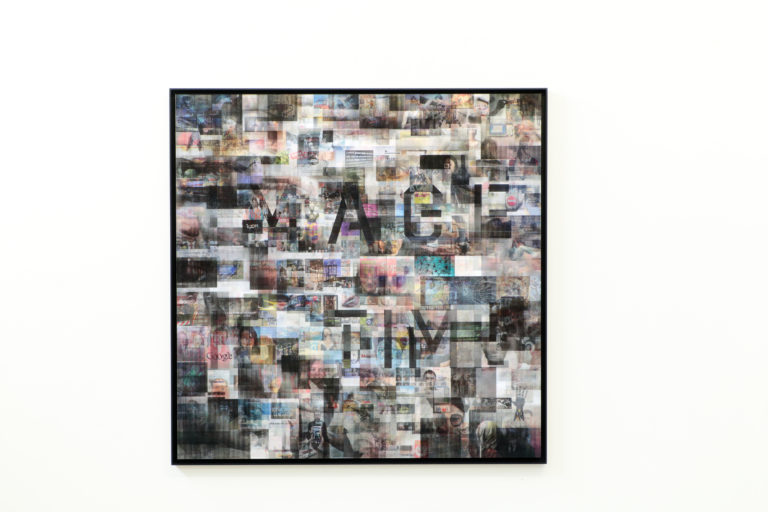
Pascal Dombis|Image Is Time|2018|
110 x 110 cm|Lenticular pirnt aluminum composite
SpamScape (2012), Lenticular print on aluminum composite, 2.20 × 2.20 m (2 panels)
Pascal Dombis, Google Google (Mirror), 2015, Lenticular print on mirror aluminum composite, 1.20 × 1.20m
Post-Digital Surface
Selected Solo Exhibitions
2022 Post-Digital, Museum of Contemporary Art, Sorocaba – BR
2021 DEJA VU, Bluerider Gallery, Taipei – TW
2021 DEJA VU, Bluerider Gallery, Shanghai – CNB
2021 Barroco! II, Galerie Odile Ouizeman, Paris ,FR
2020 Futurs Antérieurs, La Chapelle, Chaumont – FR
2020 Regards d’Artistes, Château d’Aunoy, Champeaux – FR
2019 The Invisible Generation, Galerie Pascal Janssens / Keyes Art Mile, Johannesburg – SA
Crackography, Galerie Pascal Janssens, Gand – BE
2018 IBU Gallery, Paris – FR
2017 Perspectives Inversées, Jardin du Palais-Royal & IBU Gallery, Paris – FR
Crack Time, TZR Galerie, Düsseldorf – DE
2017 Time Is Time Was, Espace Orenga de Gaffory, Patrimonio – FR
2017 Image is Time, Galerie Pascal Janssens, Gand – BE
2016 Reality is a Scanning Pattern, Stiftung Bartels Fondation, Basel – CH
2015 The Limits of Control, Galerie Pascal Janssens, Gand – BE
2015 CONTROL, TZR Galerie, Düsseldorf – DE
2015 Text(e)~Fil(e)s, Cité de la Mode et du Design, Paris – FR (cat.)
2015 The End(less), Budapest Art Factory, Budapest – HU
2014 Mixed Grill(e), RAYGUN Art Projects, Toowoomba – AUS
2014 Irrational Geometrics, Holly Hunt, New York – USA
2013 Post-Digital, TZR Galerie, Düsseldorf – DE
2013 The End(less), Nuit Blanche, Métro Gare de Lyon, Paris – FR
2013 Glitch_Stitch, Galerie Pascal Janssens, Gand – BE
2012 Extra_Vague, Galerie RX, Paris – FR
2012 Eurasia, The Cat Street Gallery, Hong Kong – HK (cat.)
2012 Eurasia, TZR Galerie, Düsseldorf – DE (cat.)
2012 Le Musée en Herbe, Paris – FR
2012 IBU Gallery, Paris – FR
2011 Gott ist Tot, Claudio Bottello Contemporary, Turin – IT
2011 Pourquoi ?What_Next ?, Nuit Blanche, Saint-Eustache, Paris – FR
2010 Text(e)~Fil(e)s, Palais-Royal, Paris – FR (cat.)
2010 IBU Gallery, Paris – FR
2010 EXCES I, The Page Gallery (Die Galerie), Seoul – KR (cat.)
2010 EXCES II, Wooson (Seok) Gallery, Daegu – KR (cat.)
2009 Image-Flux, Galerie RX, Paris – FR (cat.)
2009 Time Spirals, The Cat Street Gallery, Hong Kong – HK (cat.)
2008 Géométries Irrationnelles, Galerie municipale, Vitry-sur-Seine – FR (cat.)
2007 BLINK, Artpool, Budapest – HU (cat.)
2007 RRB, Espace Orenga de Gaffory, Patrimonio – FR
2006 @tom1k, Hôtel Pams, Mairie de Perpignan, Perpignan – FR
2005 SpamScape, Maison Populaire, Montreuil – FR
2005 Château de Linardie, Senouillac – FR
2004 Hyper-Structures, Fort Napoléon, La Seyne-sur-Mer – FR (cat.)
2004 Galerie Mabel Semmler, Paris – FR (cat.)
2002 Galerie Mabel Semmler, Paris – FR
2001 Galerie EOF, Paris – FR
Selected Group Exhibitions
2023 Homeland Universe, Bluerider ART London Mayfair, UK
2023 Voltaje, Bogotá – COL
2023 La fusion des possibles, Topographie de l’art, Paris – FR
2023 Abstraction, Bluerider Gallery, Taipei – TW
2023 Vasarely, d’un art programmatique au numérique, Espace Culturel Lympia, Nice – FR
2023 Wild Grass, Bluerider Gallery, Shanghai – CN
2023 Wild Grass, Bluerider Gallery, Taipei – TW
2023 SP-Arte, Dan Galeria, São Paulo – BR
2023 Presenças e ausências, Dan Galeria Interior, Sorocaba – BR
2023 Genesis, HTC Gallery, Taipei – TW
2023 [In]Material, Metahaus, Paris – FR (cat.)
2023 Where the words end, Recontemporary, Turin – IT
2022 As mais altas torres começam no solo, Dan Galeria, São Paulo – BR
2022 L’Ososphère, Strasbourg – FR
2022 A Midsummer Night’s Dream, Bluerider Gallery, Taipei – TW
2022 Séléné, IBU Gallery, Paris – FR
2022 Breeze, Bluerider Gallery, Taipei – TW
2021 Decision Making: L’instant décisif, Centre Culturel Canadien, Paris – FR
2021 Linha, Cor e Movimento, Dan Galeria, São Paulo – BR
2021 Crackography, Espace Jean-Roger Caussimon, Tremblay-en-France – FR
2020 Algorithm & Appropriation, Bluerider Ren-Ai Gallery, Taipei – TW
2020 Hemera, IBU Gallery, Paris – FR
2019 The Invisible Man, Wood Street Galleries, Pittsburgh – USA
2019 Linha Atemporal, Dan Galeria, São Paulo – BR
2019 ArtJaws, Zurcher Gallery, New York – USA
2019 Einsichten IV, Galerie Hengevoss-Dürkop, Hamburg – DE
2019 Cape Town Art Fair, Galerie Pascal Janssens, Cape Town – SA
2019 SP-Arte, Dan Galeria, São Paulo – BR
2019 Art Paris, Galerie Hengevoss-Dürkop, Paris – FR
2019 Wechselspiel, Pforzheim Galerie, Pforzheim – DE
2019 Mutatio, Garage Amelot, Paris – FR
2018 Artistes & Robots, Galeries Nationales, Grand Palais, Paris – FR (cat.)
2018 Cape Town Art Fair, Galerie Pascal Janssens, Cape Town – SA
2018 Carte Blanche, Galerie Hengevoss-Dürkop, Hamburg – DE
2018 The End(less) / Exo Gallery, EP7, Paris – FR
2018 KIAF, The Page Gallery, Seoul – KR
2018 Carte Blanche Zeitgenössisch, Institut Français, Hamburg – DE
2017 Cybernetic Consciousness, Itaú cultural, Sao Paulo – BR (cat.)
2017 Modus Operandi, The Société, Bruxelles – BE
2017 Interferences, Galerie NMarino, Paris – FR
2017 Cape Town Art Fair, Galerie Pascal Janssens, Cape Town – SA
2017 Das Skulpturenprojekt, Städtische Galerie, Villingen-Schwenningen – DE
2017 FNB JoburgArtFair, Galerie Pascal Janssens, Johannesburg – SA
2017 Variation, Cité internationale des arts, Paris – FR
2017 A bao a qou, Bamhaus, Luxembourg
2016 Monochrome, The Société, Bruxelles – BE
2016 Connected, Centrale for contemporary art, Bruxelles – BE (cat.)
2016 Société de Service, Plateforme, Paris – FR
2016 Cape Town Art Fair, Galerie Pascal Janssens, Cape Town – SA
2016 Interactivo, Galería Odalys, Madrid – ES (cat.)
2016 Summer Exhibition, Galerie Pascal Janssens, Gent – BE
2016 Bizarro, Galerie Frédéric Castaing, Paris – FR
2016 RE-culture 4, Agora Argyri, PATRAS – GR (cat.)
2016 The End(less), Studio Abel14, Paris – FR
2015 Nel Blu dipinto di Blu, da Yves Klein a…, Museum of Modern and Contemporary Art, Acri – IT (cat.)
2015 Perspectives, Art Plural Gallery, Singapore
2015 Ré-émergence, La Maison Populaire, Montreuil – FR (cat.)
2015 Cine Retrospective, Perth Cultural Centre, Perth – AUS
2015 ArtParis, Galerie Pascal Janssens, Paris – FR
2015 London Art15, Galerie Pascal Janssens, London – UK
2015 Voltaje, Centro Creativo Textura, Bogotá – COL
2015 Variation, Espace des Blancs Manteaux – Paris, FR
2015 The End(less), La Noche en Blanco, Bogotá – COL
2015 Arte-Scienza, Palazzo Costanzi, Trieste, IT (cat.)
2014 Art14, Galerie Pascal Janssens, London – UK
2014 ArtParis, Galerie Pascal Janssens, Paris – FR
2014 Summer Show, Galerie Pascal Janssens, Gent – BE
2014 Portrait, Galerie RX, Paris – FR
2014 Art Taipei, The Cat Street Gallery, Tapei – TW
2013 NOISE, 55th Venice Biennale of Art (Collateral Event), Venise – IT (cat.)
2013Année Lenôtre, Les Nouvelles Folies Françaises, Domaine National de St-Germain-en-Laye – FR
2013 Oltre il sublime, Art Space Luisi Spa, Trieste – IT
2013 Wonder Works, The Cat Street Gallery, Hong Kong – HK
2013 Plaisir, Galerie RX, Paris – FR
2013 Made in light, Fondation Vasarely, Aix-en-Provence – FR
2013 Made in light, Fondation EDF, Paris – FR
2013 Artshow Busan, The Page Gallery, Busan – KR
2013 Show Off, the Media Art Fair, Galerie RX, Paris – FR
2013 KIAF, The Page Gallery, Seoul – KR
2012 Schrift und Bild, Museum Kunstpalast, Düsseldorf – DE
2012 Won Ocean, Neue Galerie Gladbeck, Gladbeck – DE
2012 Plaisir, Galerie RX, Paris – FR
2012 Update_4 Biennal, iMAL, Bruxelles – BE
2012 Non & Digital, The Central House of Artists, Moscow – RU
2012 Show Off, the Media Art Fair, Paris – FR
2012 Autour du Psychedelisme, Galerie Janos, Paris – FR
2011 Hybrid Boy, TZR Galerie, Düsseldorf – DE
2011 HK Art Fair, The Cat Street Gallery, Hong Kong – HK
2011 SOAF, The Page Gallery, Seoul – KR
2011 Signal 8, The Cat Street Gallery, Hong Kong – HK
2010 Tou_R0se, Traverse, Centre Bellegarde, Toulouse – FR
2010 Salon Dessin Contemporain, Galerie RX, Paris- FR
2010 HK Art Fair, The Cat Street Gallery, Hong Kong – HK
2010 New Era, Galerie RX, Paris – FR
2010 Paratissima, Claudio Bottello Contemporary, Turin – IT
2009 EcritureAbstraction, Galerie RX, Paris – FR
2009 HK Art Fair, The Cat Street Gallery, Hong Kong – HK
2008 Imaging by numbers, Block Museum, Chicago – USA (cat.)
2008 art.ficial 4.0, Instituto Itaú cultural, Sao Paulo – BR (cat.)
2008 Great wall of Oakland, Oakland – USA
2008 Videoholica 08, Velchev Art Museum, Varna – BU
2008 Signal 8, The Cat Street Gallery, Hong Kong – HK
2007 Traverse, Centre Bellegarde, Toulouse – FR (cat.)
2007 Victory Media Network, Dallas – USA
2007 Slought in Berlin, Galerie Heike Curtz, Berlin – DE
2007 Slick, Galerie Numeriscausa, Paris – FR
2006 Almost Art, Slought Fundation, Philadelphia – USA
2006 Process Revealed, Artpool, Budapest – HU
2006 Trampoline, Broadway Media Centre, Nottingham – UK
2005 Espace Recherches / DesignLab, Salon du Meuble, Paris – FR
2005 Nuit d’Art, Place Saint Sulpice, Paris – FR
2004 Plasticité, Galerie Mabel Semmler, Paris – FR
2004 Generative Art Conference, Milan – IT
2004 International Festival of Electronic Art 404, Rosario – AR
2004 Canon Digital Creator Award, SVA Computer Art, New York – USA
2003 Canon Digital Creator Award, Spiral gallery, Tokyo – JP (cat.)
2002 Espace Cardin, Paris – FR
2000 Le temps fractal, Galerie Xippas, Paris – FR (cat.)
2000 Universal Concepts Unlimited, New York – USA
1999 Fractalisations, Villa Tamaris, La Seyne-sur-Mer – FR (cat.)
1999 Fractalisations,Abbaye de Ronceray, Angers – FR
1999 Habiter les réseaux, Galerie de l’école des Beaux-Arts, Metz – FR
1999 Centre Culturel Français, Turin – IT
1997 Fractal Art, Fondation Ricard, Paris – FR (cat.)
1997 Fractal, Palazzo Economo, Trieste – IT
1997 Zoom, Visual Arts Gallery, Purchase College, New York – USA (cat.)
1997 Caos Vertiginoso, Galleria Cruce, Madrid – SP
1996 Microcosmos, University of Georgia, Athens – USA
1996 Vous avez dit Fractal, Musée, Médiathèque, Le Parefeuille, Enclos de la Source, Uzès – FR
1996 Modernita, Palazzo Bricherasio, Turin – IT (cat.)
1995 Galerie Arx, Turin – IT (cat.)
1995 Art Fractal, Galerie Angle, Saint-Paul-Trois-Châteaux – FR
1994 Ars Electronica (Honorary Mention), Linz – AT (cat.)
1993 Salon de Montrouge, Montrouge – FR (cat.)
1991 Salon de Montrouge, Montrouge – FR (cat.)
1991 Jeune Peinture, Paris – FR (cat.)
1990 Jeune Peinture, Paris – FR (cat.)
1988 Multi Media Art Gallery, New York – US
1988 Plan de Travail, Lyon – FR
1986 Plan de Travail, Lyon – FR
Publications
2018 Pascal Dombis, Monograph, Supernova éditions
2018 L’art au-delà du digital, Dominique Moulon, nouvelles éditions Scala
2018 Artistes & Robots, Laurence Bertrand Dorléac, Jérôme Neutres, Réunion des musées nationaux
2015 Art et Numérique en résonance, Dominique Moulon, Maison populaire et les nouvelles éditions Scala
2015 Mathematics and Art – A Cultural History, Lynn Gamwell, Princeton University Press
2014 Géométrie de l’excès, Michel Verlinden, Focus Vif Express
2013 Lettering Large The Art and Design of Monumental Typography, Steven Heller & Mirko Ilic, The Monacelli Press
2013 Artpool – The Experimental Art Archive of East-Central Europe, Artpool, Budapest
2012 A New Regime of Images, Christine Buci-Glucksmann, Art Absolument
2012 Pascal Dombis’ Eurasia, Kay Heymer, TZR Galerie, Düsseldorf
2011 CensorZip, Pipeline Magazine, issue #24
2011 Spigolature tra Venezia e la Francia, Giancarlo Pagliasso, revue Zeta
2010 Aesthetics of Digital Art, Simon Erohin, publisher: Aletheia (Russian)
2010 Exces, Henri-François Debailleux, Die Galerie, Seoul
2009 Art, Code, and the Engine of Change, Paul Hertz, CAA Art Journal
2008 Philosophie de l’ornement : D’Orient en Occident, Christine Buci-Glucksmann, Galilée
2007 From Technological to Virtual Art, Frank Popper, MIT Press
2007 SpamScape, Maria Maccotta et Pierre Vermeersch, La Re-Visite, Traverse, Toulouse
2007 Dombis fait bonne impression, Henri-François Debailleux, Libération
2006 Au-delà de la mélancolie, Christine Buci-Glucksmann, Galilée
2004 La Main de l’Homme, Blackhawk, La Seyne-sur-Mer
2002 La folie du voir, Christine Buci-Glucksmann, Galilée
2002 Pascal Dombis : Les peintures bien roulées de la computation, Joseph Nechvatal
2002 Dombis, des lignes à l’infini, Henri-François Debailleux, Libération
2000 L’art depuis 1945, Hervé Gauville, Hazan
Public Arts
2020 Lujiazui HARBOUR CITY, Pascal Dombis & Gil Percal, , Shanghai, CN
2016 Ecole Nationale d’Architecture de Strasbourg, Pascal Dombis and Gil Percal, FR
2015 Kings Square, Pascal Dombis and Gil Percal ,Perth, AUS
Collections
Daegu Art Museum, Daegu, KR
Ville de Vitry-sur-Seine – FR
Musée des Beaux Arts, Szepmuveszeti Muzeum, Budapest – HU
Seiko Epson Corp. – JP
Canon Inc. – JP
Victory Arts Collection – USA
Block Museum, Chicago – USA
Fondazione Palazzo Bricherasio – IT
Yageo Foundation – TW
